After a short stop in the stunning, colorful city of Valparaíso, we set off towards the ultimate goal of our South American trip: Patagonia! Our love for trekking and wide open spaces naturally brought us here. Pucón is the first stop in southern Chile, and this little town has plenty of surprises in store… Let’s go for a tour of the city and its surroundings!
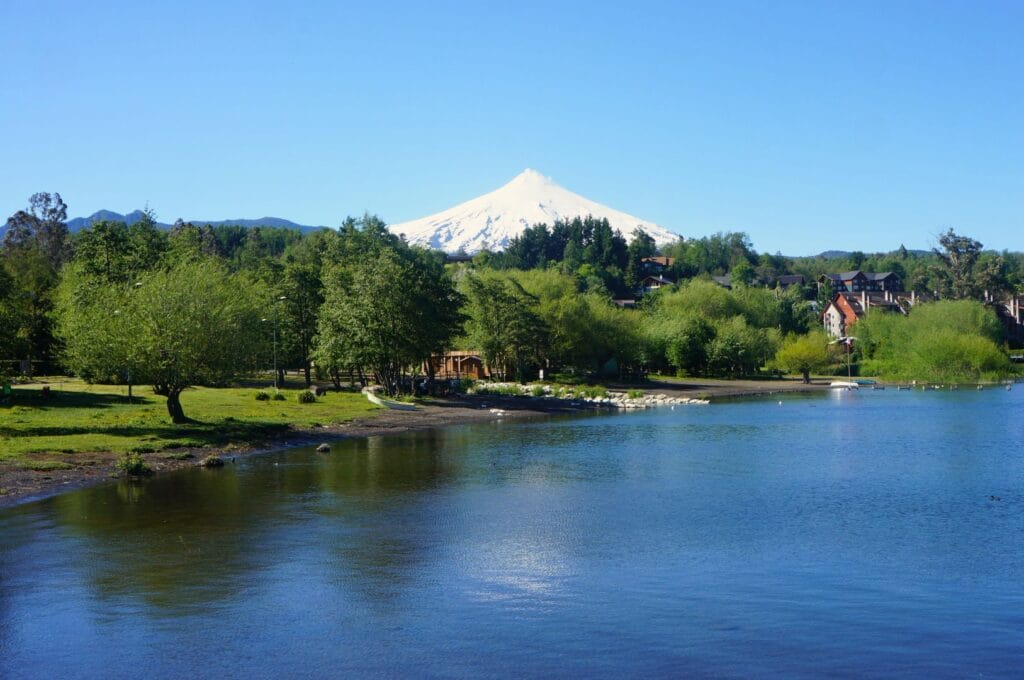
We took this trip in 2014, but the article was completely revised and updated in October 2024. If you see any price changes or have additional information that might be relevant, please feel free to leave us a comment!
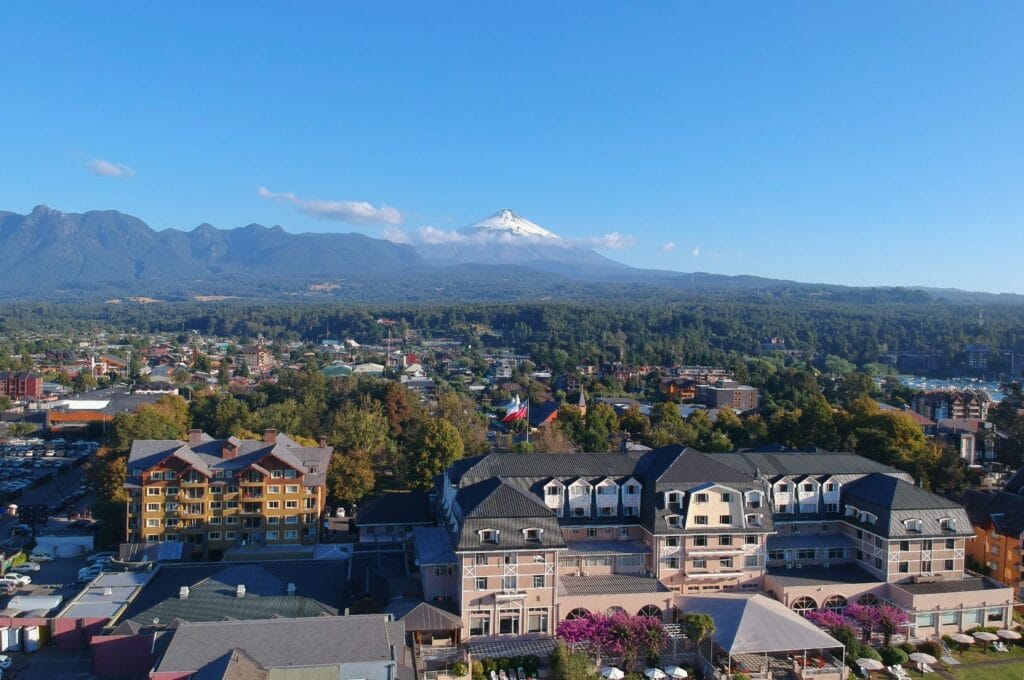
Pucón, a Chilean paradise
To be honest, we didn’t know much about Pucón… We only saw a photo of this small town nestled by a lake with the Villarrica Volcano in the background. When we arrived, a little smile immediately appeared on our faces. It felt almost like being in Switzerland! The town of 22,000 inhabitants is very charming and extremely clean, and the main street reminded us more of Gstaad or Zermatt than South America! Of course, the volcano adds a different touch to this ski resort—our own Matterhorn isn’t going to start spewing lava anytime soon!
In any case, whether summer or winter, Pucón attracts both locals and travelers because of the many natural attractions in this region of Araucanía! From December to March, it’s summer, perfect for hiking. If you prefer winter sports, the best time to visit Pucón is from June to August. Don’t forget that the seasons are reversed in the southern hemisphere. 🙂
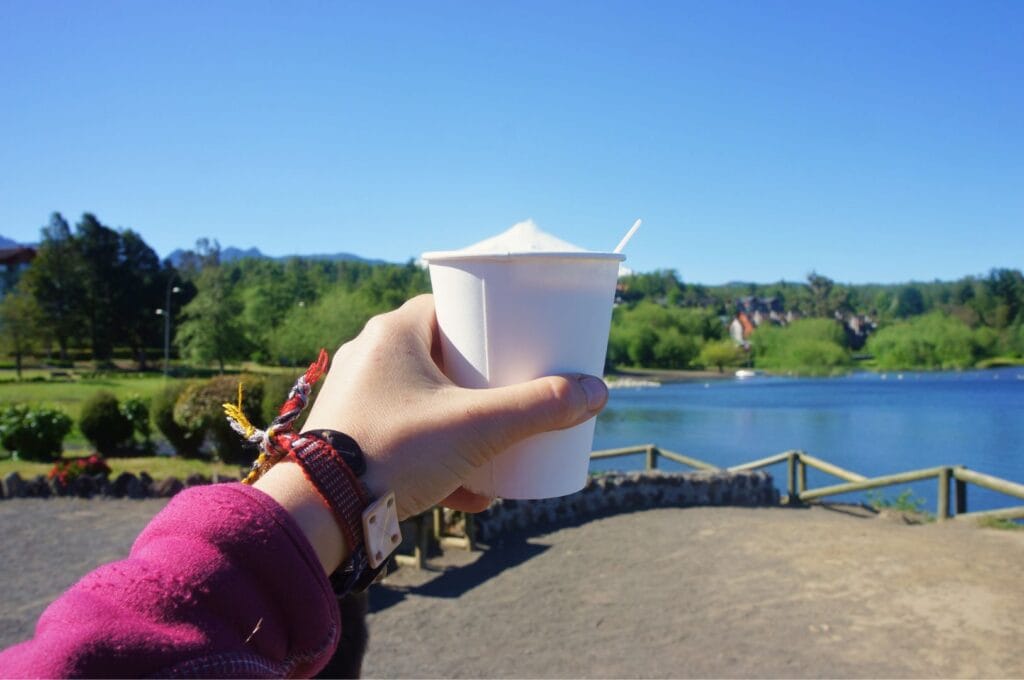
How to get to Pucón
From Valparaíso
From Valparaíso, the most convenient option is to take a night bus for 13 hours with Pullman and Transantin, with tickets starting at 18,500 pesos. Another possibility is to take a bus between Valparaíso and Santiago (2 hours), and then use another transport option, detailed below.
From Santiago
The bus is the best way to travel between Santiago and Pucón, as the town is served by the major bus companies: Jet Sur, Pullman, Turbus, JAC… Buses run throughout the day, but we recommend taking a night bus to save on a night’s accommodation. The journey on a cama bus takes about 10 hours. Compare tickets and check schedules here.
You can also fly from Santiago (a 1.5-hour flight), but the closest airport to Pucón is Araucanía International Airport in Temuco. From Temuco, you will need to take a second bus for a 2-hour ride.
Another option is the train! This is for those who love slow travel, with a 12.5-hour journey. However, trains are infrequent. Ticket prices start at 23,900 Chilean pesos. Once in Temuco, you’ll need to take a bus to Pucón.
From Chillán
Between Chillán and Pucón, the most economical option is this cama bus, with a 6.5-hour journey and tickets starting at 17,000 pesos per person.
From Puerto Varas and Puerto Montt
Only the JAC bus company runs a direct route from Puerto Varas to Pucón (5 hours, 16,000 pesos). If the schedule doesn’t suit you, you’ll need to take a bus from Puerto Varas to Puerto Montt (30 minutes, 3,000 pesos), and then a second bus from Puerto Montt to Pucón (5 hours 20 minutes, 16,600 pesos).

This article contains affiliate links to partner sites. When you use our links to book accommodation, a car, or an activity, you don’t pay anything extra, but we get a small commission. This helps us to offer you free, independent, and ad-free content. Thank you for your support!
Accommodation in Pucón
We stayed at the excellent B&B de German, a charming inn that offers double rooms with views of Villarrica Volcano. This wooden house, full of character, has a pool and garden. The breakfast is simply delicious! Bonus: this B&B is located in the heart of Pucón.
For an affordable hostel, we recommend Hostel Raíz. The prices are very reasonable for a cozy stay in the city center. Two other great options are Hostal Quillelhue and Hostal Maitahue, both offering good value for money without breaking the bank in Pucón.
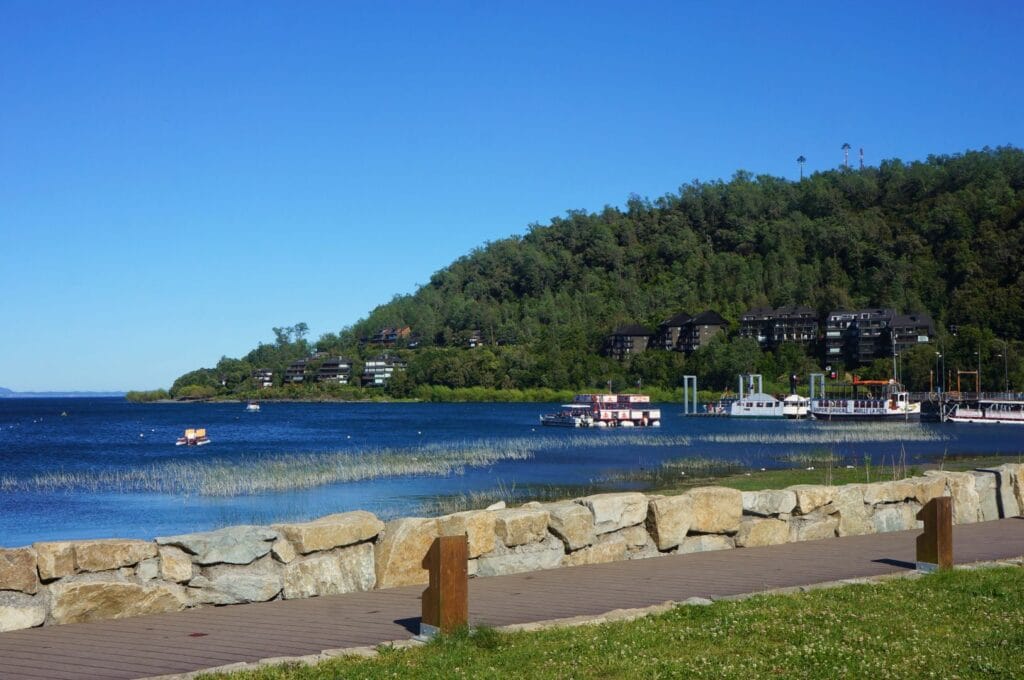
What to do in Pucón?
Stroll around town
The town itself is probably not the main reason for visiting, but it’s worth spending a few hours exploring. Head to the marina for a great sunset view over Villarrica Volcano. Another point of interest is the Mirador El Cristo, accessible via a path that passes through the municipal cemetery! The view over Pucón and the lake is quite nice. If you’re up for some beach time, Playa Grande, north of the town, is perfect for relaxing and catching the last rays of sunshine.
Lastly, you should visit the Salto El Claro waterfall, located 6 km southeast of the town. The region is full of waterfalls, but if you don’t have time for the waterfall route, we highly recommend this one! El Claro is 90 meters high and cascades into the heart of the native forest. Note that there are stairs, and it’s steep! The entrance fee is 5,000 pesos per person (3,000 for children). If you don’t have a rental car, you can hitchhike, take a colectivo, or walk there. 🙂
Note: if you only have 1 day to spend in Pucón, we recommend this guided tour to see the essentials of the area!
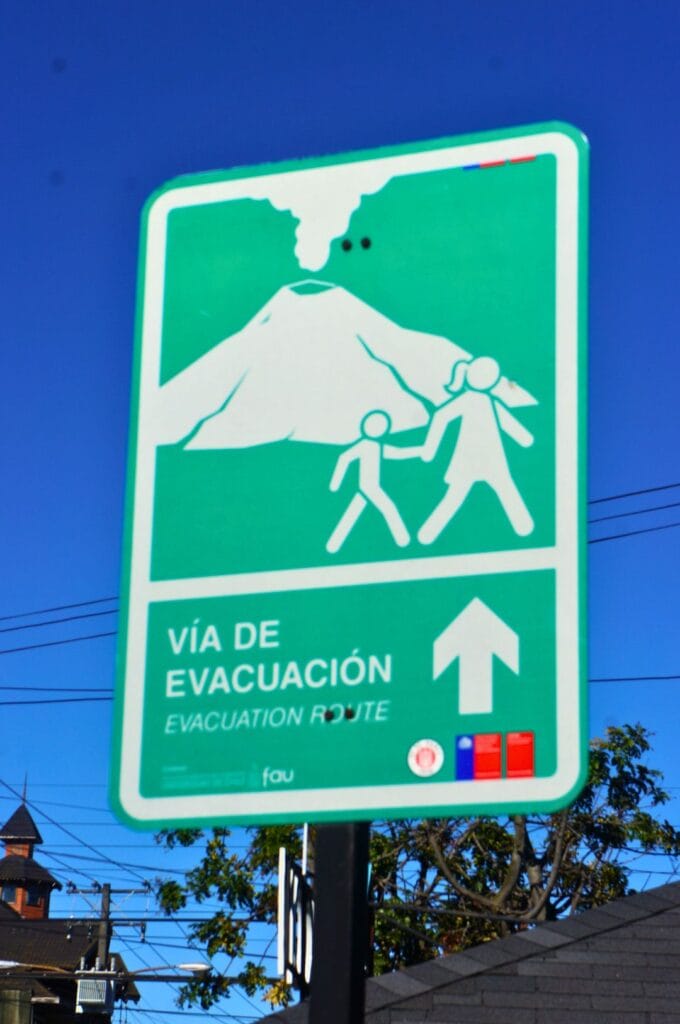
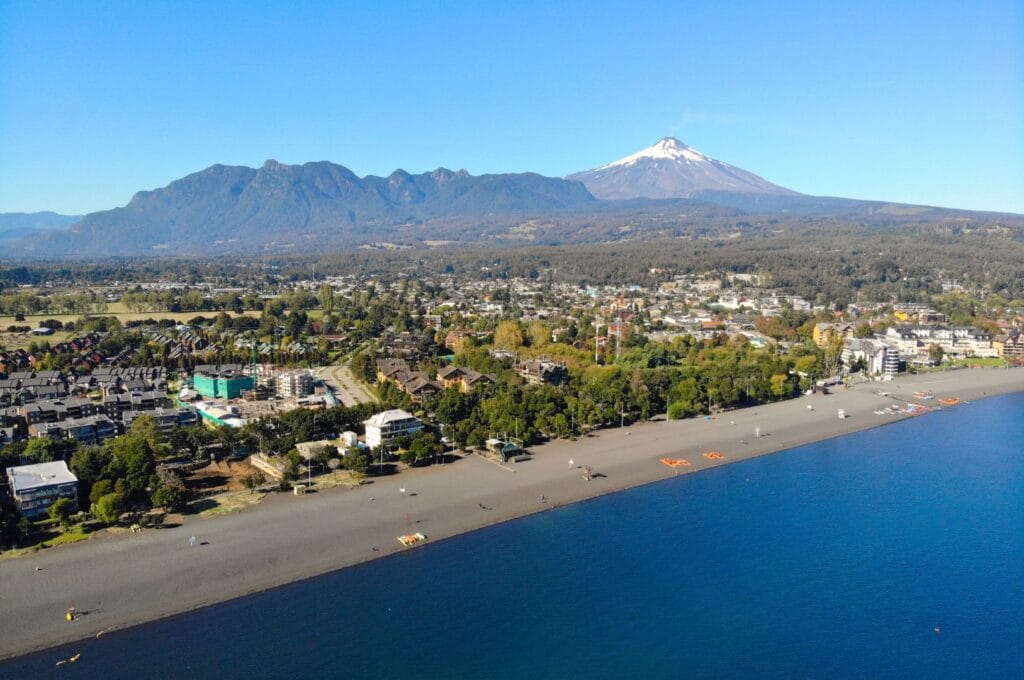
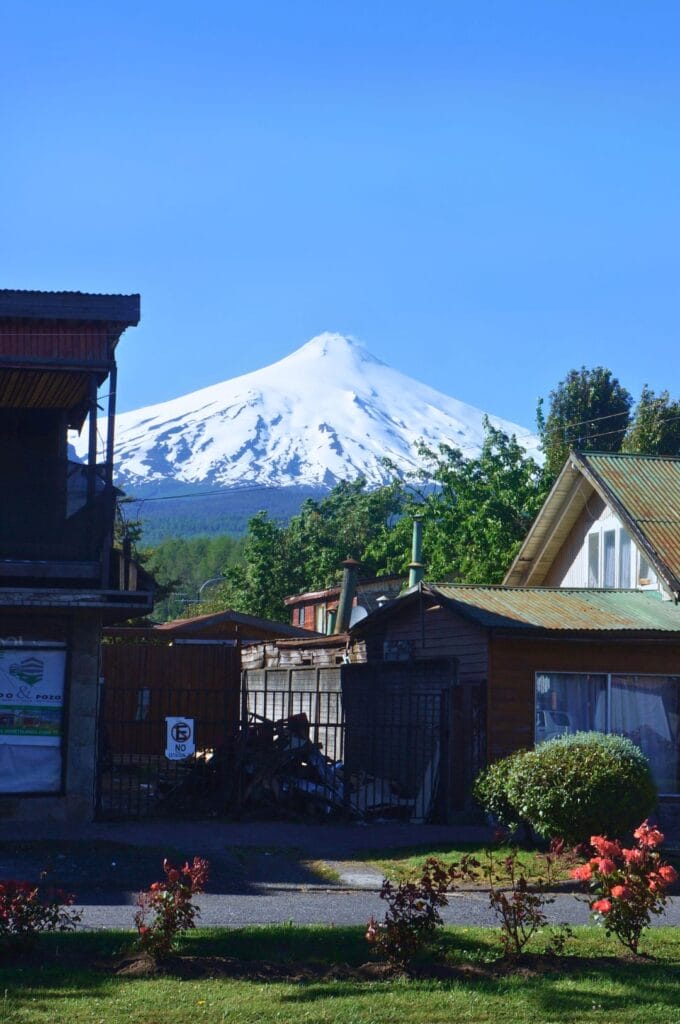
Outdoor activities
Lake Villarrica and the surrounding reserve offer a perfect playground if you enjoy outdoor activities and water sports! You can go kayaking on the Trancura River, paddleboarding on Lake Villarrica, horseback riding, zip-lining, and much more.
Climb Villarrica volcano
With over 65 eruptions in half a century, the Villarrica volcano is known as one of the most active volcanoes in Chile! And it’s for its beautiful eyes – or should I say its beautiful crater – that many travelers pass through Pucón, in the Villarrica National Park. You can easily reach its peak at 2861 meters in just a few hours, and take a peek into the heart of this active volcano!
Why we didn’t do this trek
Even so, we didn’t climb the Villarrica. There are 2 reasons for this: the price and the crowd.
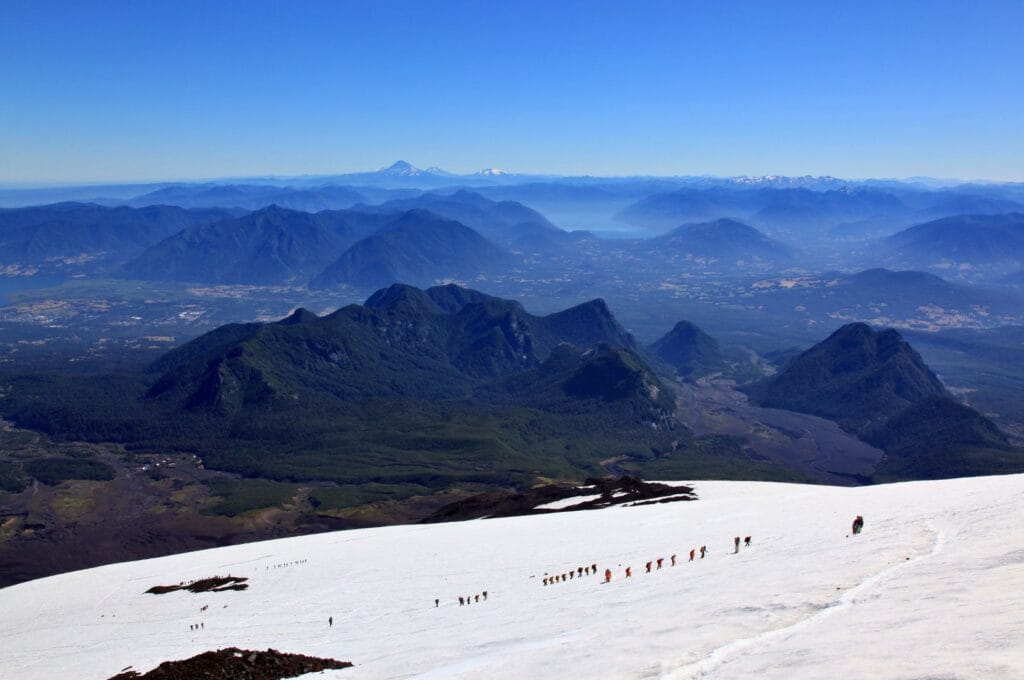
To reach the summit of Villarrica Volcano, you must go through an agency. Guides will accompany you, all the necessary equipment is provided, including gas masks, and they are familiar with the dangers of altitude and glacier hiking. You should expect to pay at least 100,000 Chilean pesos per person, which is about 100 euros! Sure, it’s not a huge amount to reach the top of an active volcano with a professional guide, but for a backpacker’s budget, it’s a bit steep. Especially since we’ve already had the chance to climb other volcanoes: Mount Batur and Rinjani in Indonesia, Cotopaxi in Ecuador, and Parinacota in Bolivia.
The second reason is the crowd! This activity is very popular, and for good reason. But as a result, nearly 250 people climb the slopes of Villarrica Volcano every morning from Pucón! Honestly, the idea of walking for 4 hours in a single file line didn’t appeal to us much.
Details of the Villarrica ascent
Here’s the map for the Villarrica Volcano ascent, and you can download the GPS track here.
In total, you should allow around 9 hours for the entire activity, with 6 hours to go up and down the flanks of the volcano. The hike is 8.1 km long with 1,404 meters of elevation gain. There’s also a paid chairlift (10,000 pesos) that saves you 1.5 hours of walking, 1.2 km, and 400 meters of elevation at the start of the trail. It’s not the hardest part of the hike, but it can save you some effort! One fun thing about this hike is the descent. If conditions allow, you can slide down part of the snowy trail on a sled!
As for the best time to go, we recommend making the ascent between September and June, knowing that summer in Chile runs from December to March. As you can imagine, conditions are better during the summer season. In winter, between June and September, the chances of the trail being partially or completely closed are high.
If you want to do it, we suggest booking your tour the day before or even two days before. As with any high-altitude activity, it’s best to keep an eye on the weather to ensure good conditions for the climb. On a clear day, the view from the summit is incredible!
For the climb to the summit, we recommend this tour. Mountain equipment is included (jacket, pants, boots, crampons, helmet, ice axe…), and you’ll have a guide for every three hikers.
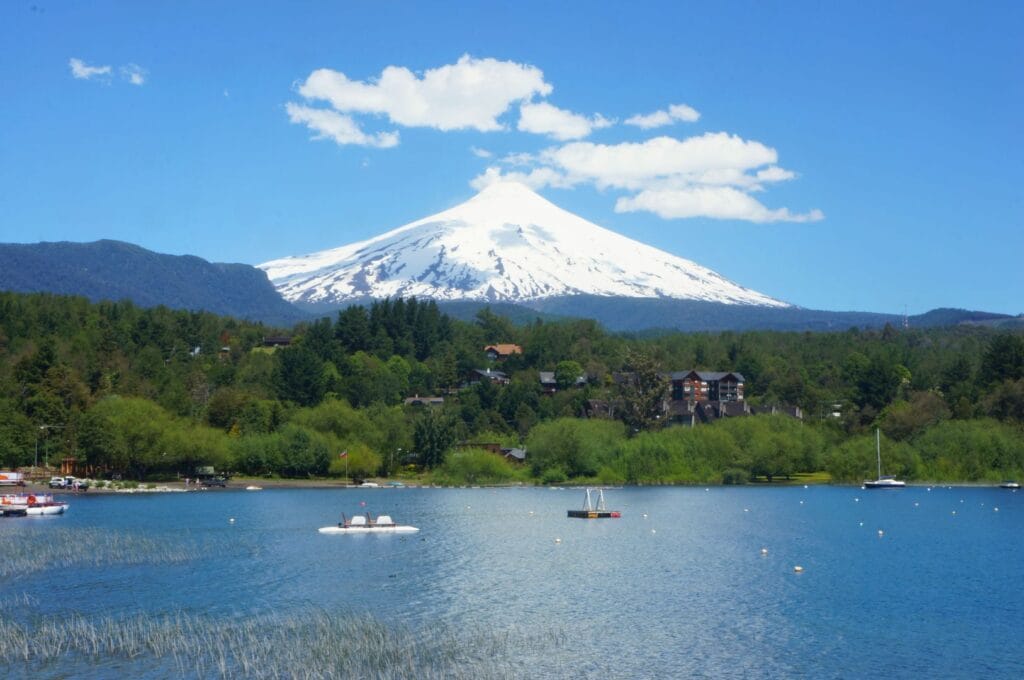
The Villarrica Traverse
The disappointment
If we came to Pucón, it was originally to do a spectacular 5-day trek: the Villarrica Traverse! Five days of trekking, 73 km on a trail that crosses Villarrica National Park, passing between the Villarrica and Quetrupillán volcanoes on the Chilean side, with a stunning view of Lanín Volcano on the Argentine side. It was set to be a challenging but beautiful trek!
We were really excited when we went to the CONAF (Chilean National Parks Organization) office to get detailed information. When we explained our plan to the ranger, he just laughed. “You’re funny. But it’s not possible! Right now, there’s still more than a meter of snow on the trail! Actually… the trail is practically non-existent, and you won’t be able to move through such a massive amount of snow!”
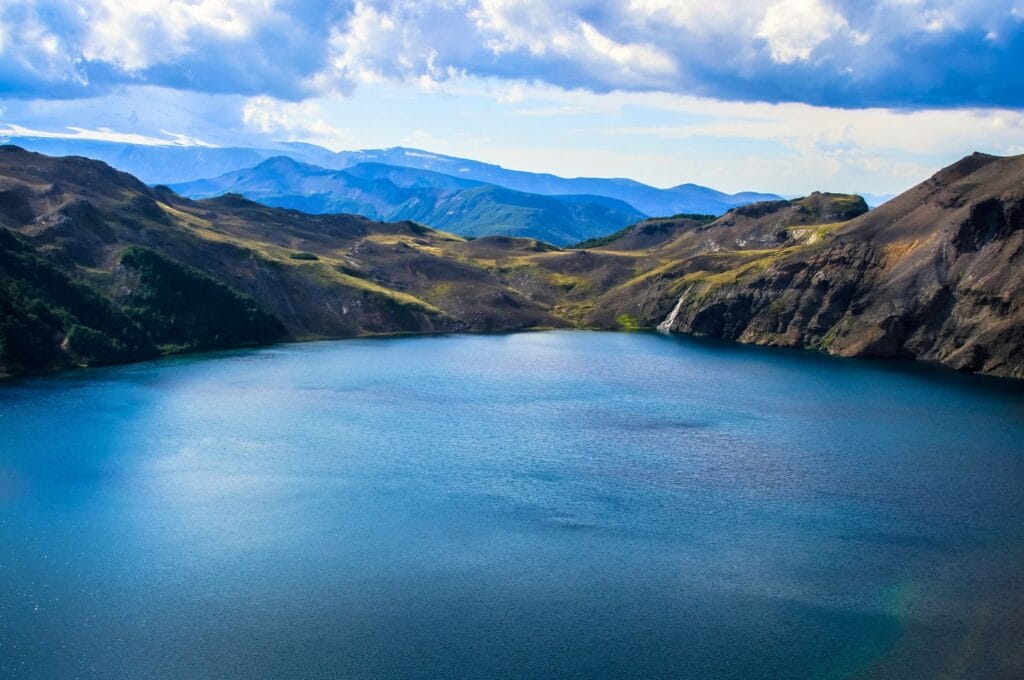
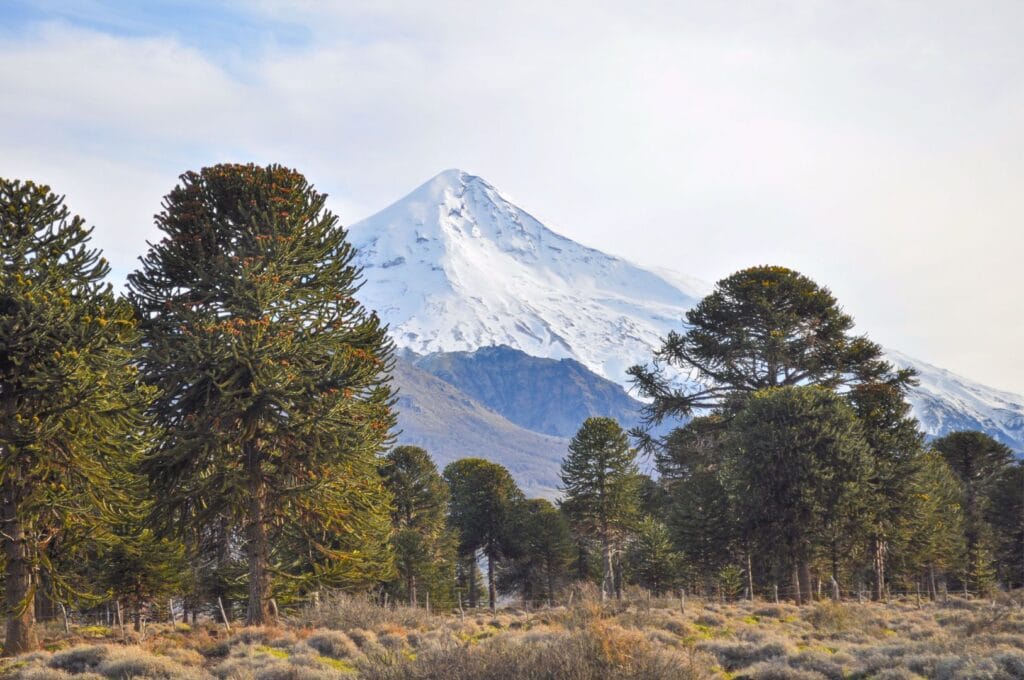
Huge disappointment for us! In reality, this trek is impossible before mid-December, and sometimes even mid-January in certain years. Needless to say, we couldn’t wait until then. But we still wanted to do something, so we started looking for another activity at a lower altitude!
Practical info
If the Villarrica Traverse tempts you, here’s all the information you need to organize your trip. In summary, this trek includes:
- 73 km over 5 or 6 days
- More than 3,000 meters of elevation gain
- Starting point: Pucón ski resort (hitchhike to get there)
- Arrival: Puesco Norte, near Argentina (hitchhike back to Pucón)
- Camping only (free), no refuges
- Ticket for Villarrica National Park: 10,000 pesos per person
Here’s the map of the trek you can download here.
You can also do the Villarrica Traverse in 3 days, starting from the CONAF office in the Chinay sector (marked on the map above), between the Villarrica and Quetrupillán volcanoes. This will make the trek 43 km instead of 73 km. Read about Allie’s 3-day trek here and find further information in this PDF.
If you complete the trek in 3 or 6 days, feel free to share your experience with us in the comments!
What to do around Pucón?
Lake Caburgua and the Ojos del Caburgua
If you have some time, a visit to Lake Caburgua might be worth it. On one side, you’ll find Playa Negra in the village of Caburgua, a beautiful beach with black sand. A bit further north, there’s Playa Blanca, a quieter beach with white sand, as the name suggests. In both cases, the scenery is stunning, with the surrounding mountains and the lake’s incredible transparency.
On the way, you can also stop by the Ojos del Caburgua. These two pools and waterfalls are famous for their transparency and stunning color. You can probably guess why they’re called Ojos, meaning “eyes” in Spanish! The entrance fee is 2,000 pesos per person, and you’ll walk on a network of wooden walkways with stairs. If you don’t have a car, this guided tour lets you discover the must-see sites around Pucón, including the Ojos del Caburgua.
To get there by bus, go to Pucón’s terminal on Uruguay Street. Departures are at 7:45 a.m., 9 a.m., 10 a.m., 10:30 a.m., and 11 a.m., and returns from Playa Blanca are at 6:30 p.m. and 7:20 p.m. Make sure to tell the driver if you want to stop at the Ojos (1,500 pesos one way), Caburgua (3,000 pesos one way), or Playa Blanca (3,400 pesos one way).
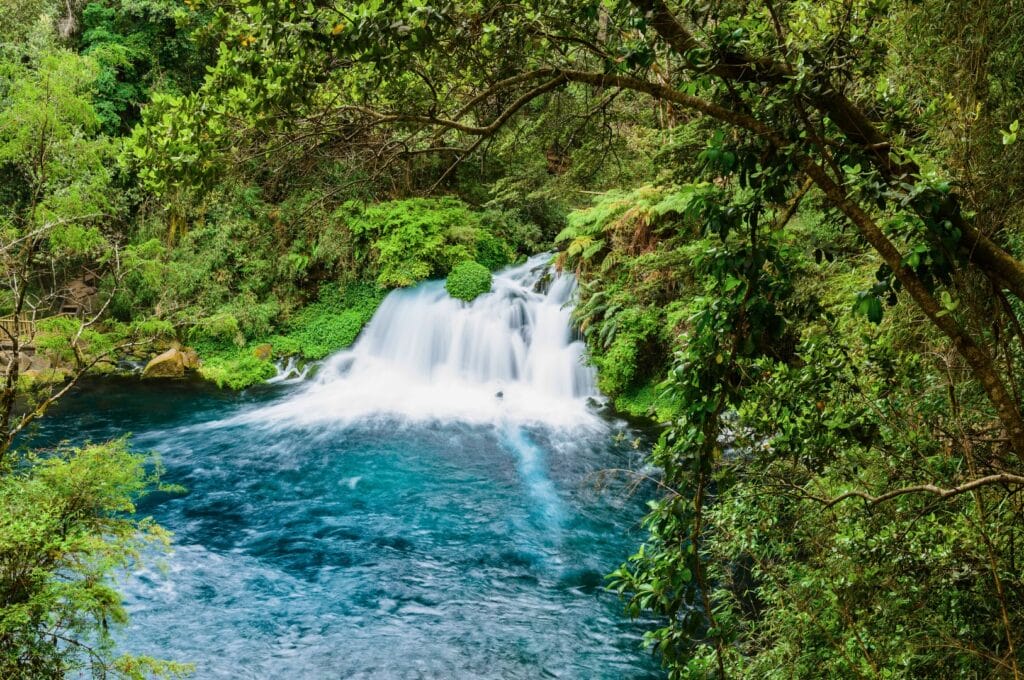
Santuario El Cañi
Located 21 km from Pucón, Santuario El Cañi is a private 500-hectare sanctuary protecting the biodiversity of the Andean forest. There’s only one hiking trail through the reserve, but what a trail it is! You’ll enjoy views of the Lanín, Quetrupillán, and Villarrica volcanoes, lagoons, endemic flora, and more. The trail is 17 km long with 1,237 meters of elevation gain, so it’s best suited for hikers in good physical condition. If you’re equipped, Santuario El Cañi has several refuges where you can set up your tent. Ask for a detailed map at the entrance.
The sanctuary is open every day from 8:30 a.m. to 8:00 p.m., but you must enter between 8:30 a.m. and 12:00 p.m. The entrance fee is 5,000 pesos per person, payable online or on-site. To get there from Pucón, take the bus from the Pullman terminal on Palguin Street. The ticket costs around 3,000 pesos per person.
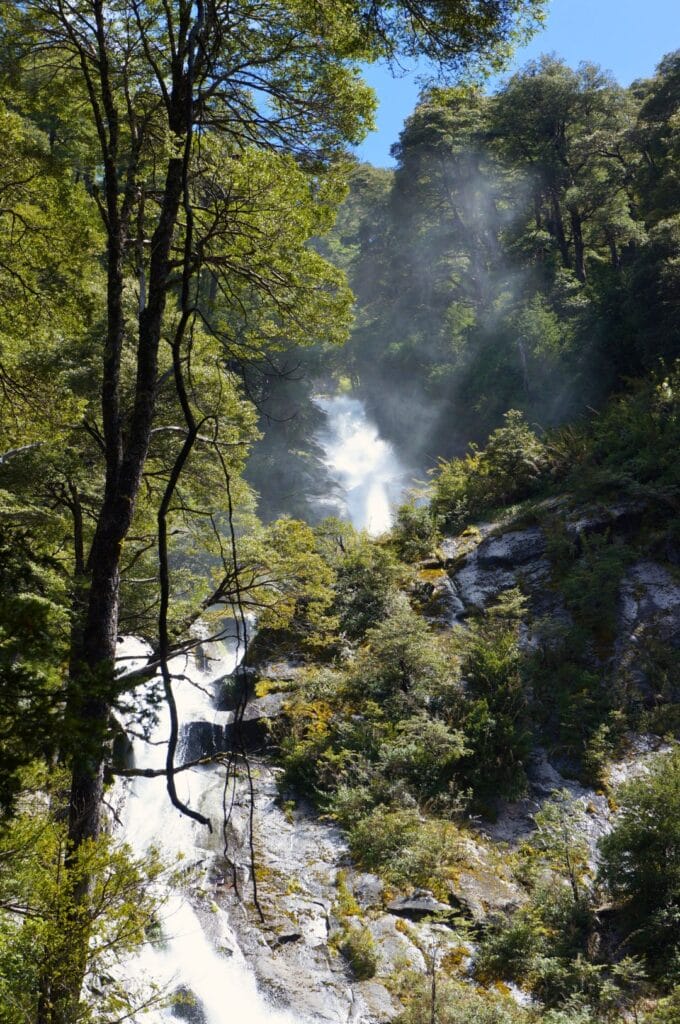
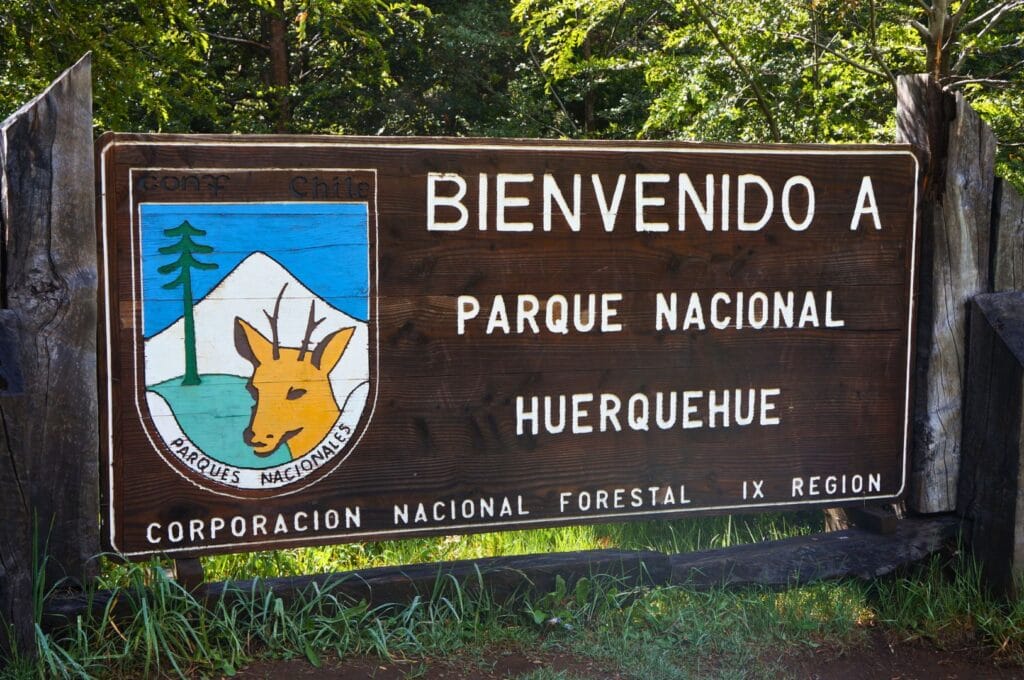
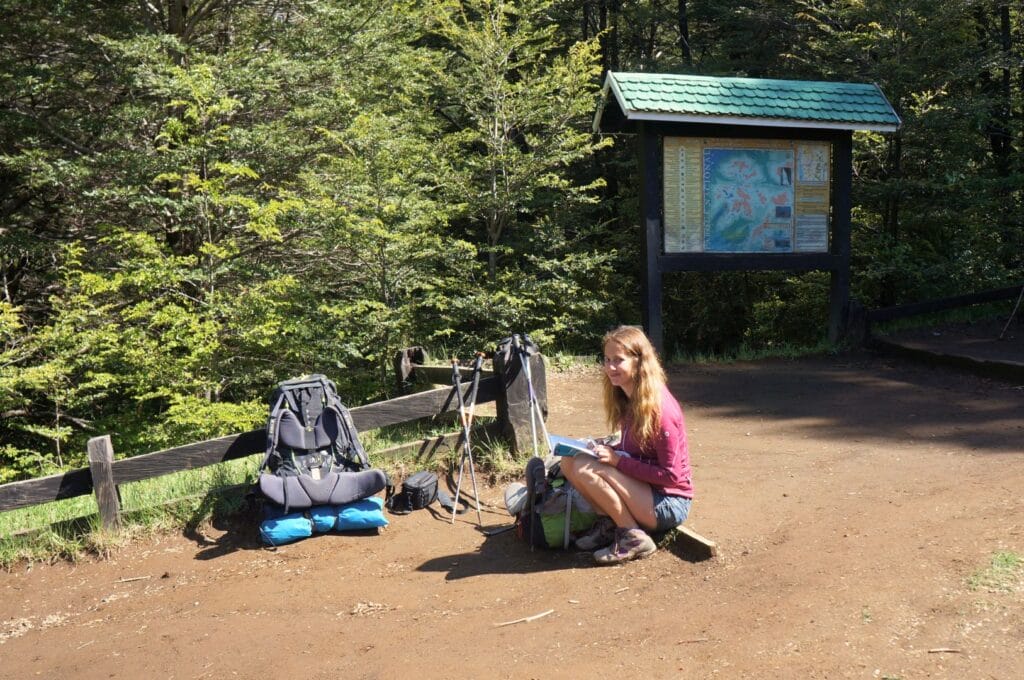
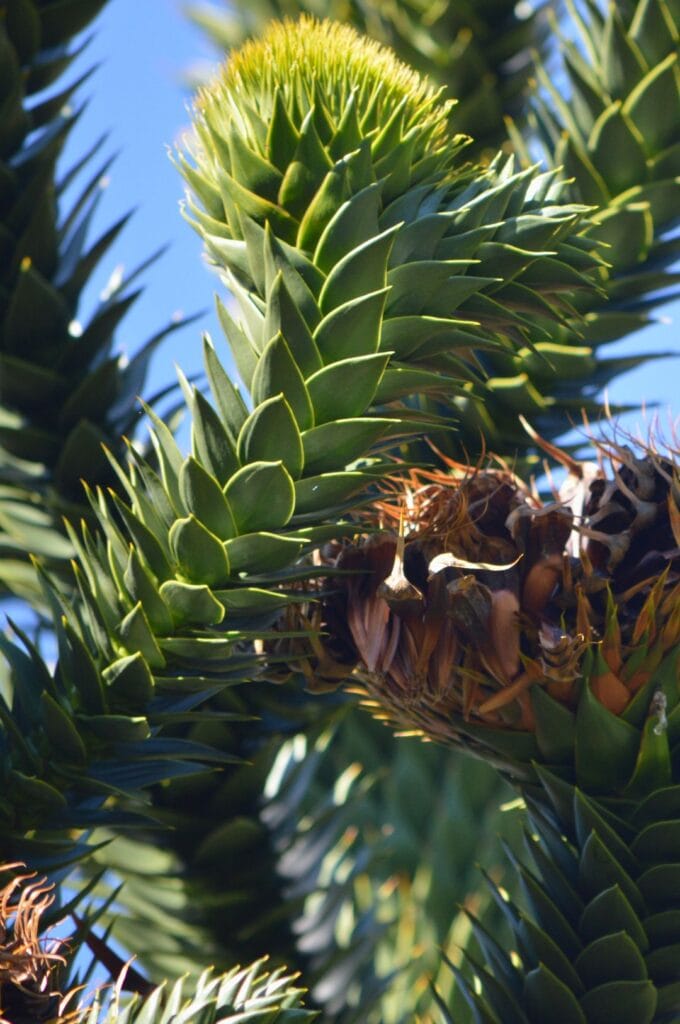
Huerquehue National Park
After our disappointment with the Villarrica Traverse, our plan B was Huerquehue National Park! Covering 125 square kilometers, with dozens of small lakes and lagoons, well-marked hiking trails, and stunning waterfalls, this park is particularly known for its incredible flora, especially the araucarias, ancient trees also known as monkey puzzle trees. These trees really amused us. For the scientific explanation, we suggest you check out the Wikipedia page, but in our opinion, it looks like a pine tree mated with a palm tree, and a cactus butt in! 😉
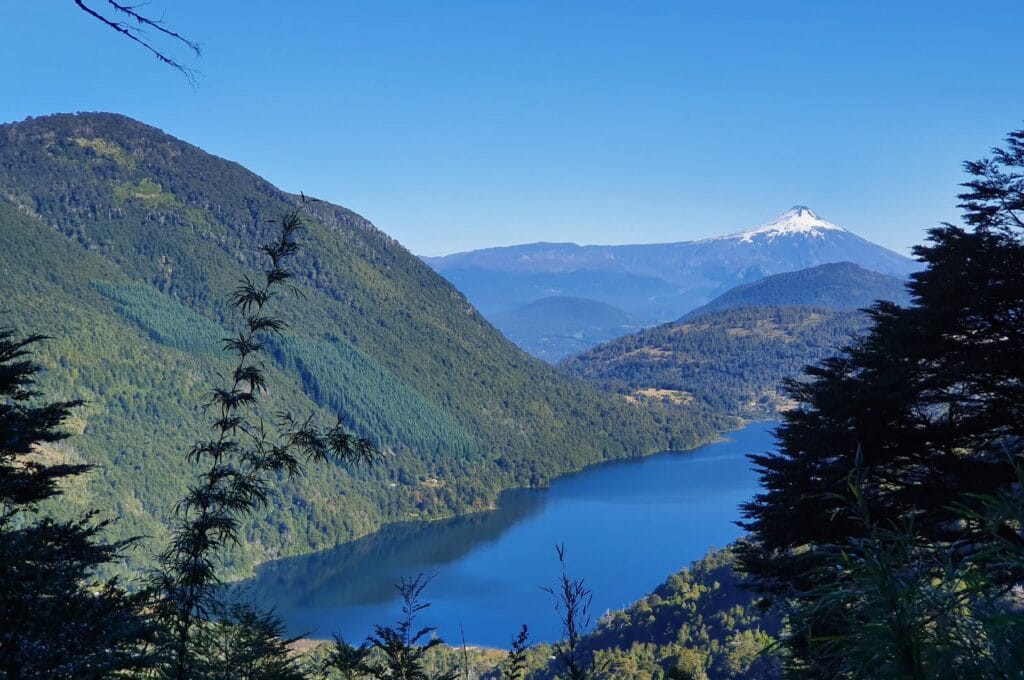
Map of Huerquehue National Park
We’ve listed the hiking trails on the map below, which you can download here.
Treks in Huerquehue National Park
You can visit the park in one day from Pucón. Take the morning bus, hike a loop through the park via the Lakes Trail, and return to the entrance to catch the last bus back to Pucón. We highly recommend this route for a great overview of the surrounding nature. We, however, wanted to do a multi-day trek to prepare for the rest of our adventure in Patagonia. So, we decided to traverse the park via the Lakes Trail in two days! Here are the details of the three main trails in Huerquehue Park:
- The Lakes Trail (in red): 13 km, 780 m elevation gain, 6 hours round trip.
- Cerro San Sebastián ascent (in blue): 13 km, 1,160 elevation gain, 7-8 hours.
- The third trail, which we took to reach the Rio Blanco hot springs from Lake Toro at the end of the Lakes Trail, is no longer passable today. However, in winter, you can reach Laguna Pehuen east of the park from the hot springs. It’s the green trail on the map (8.3 km with a 600 m elevation gain).
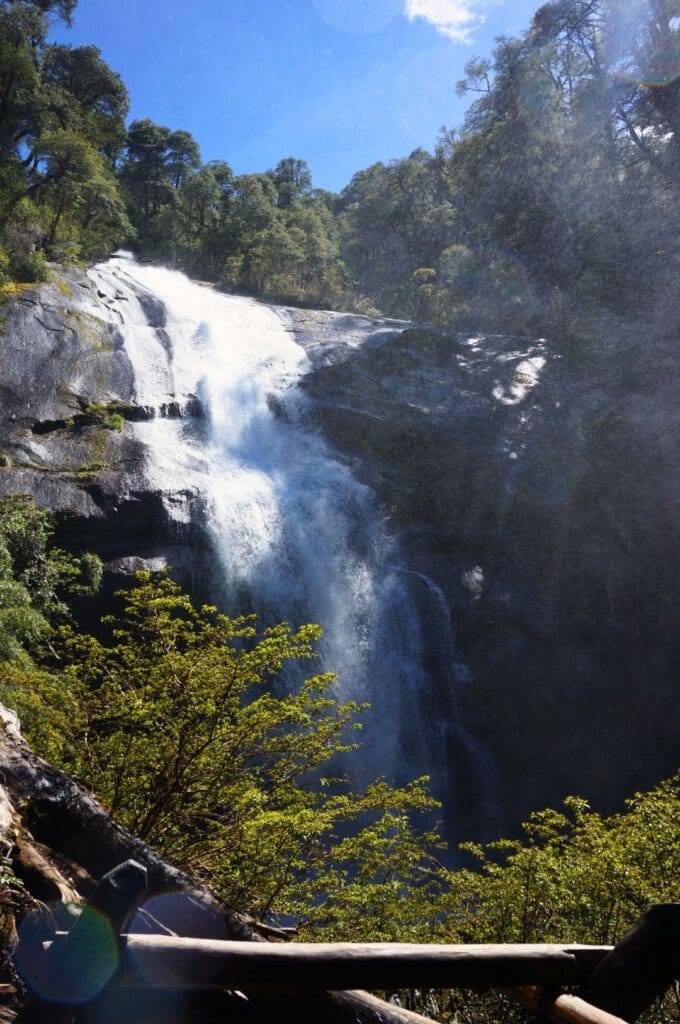
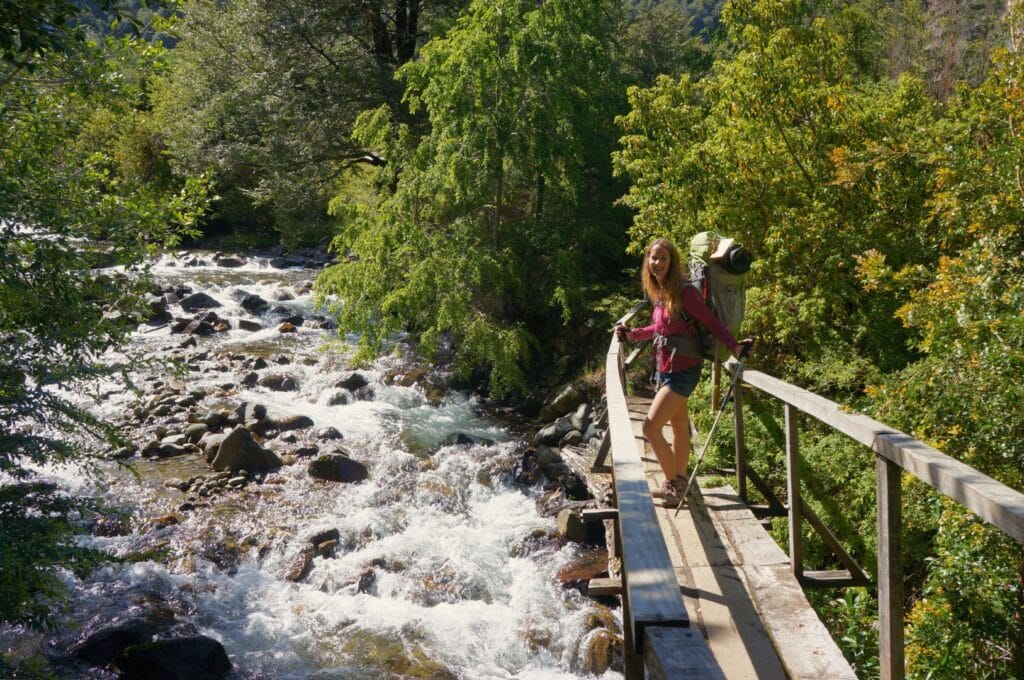
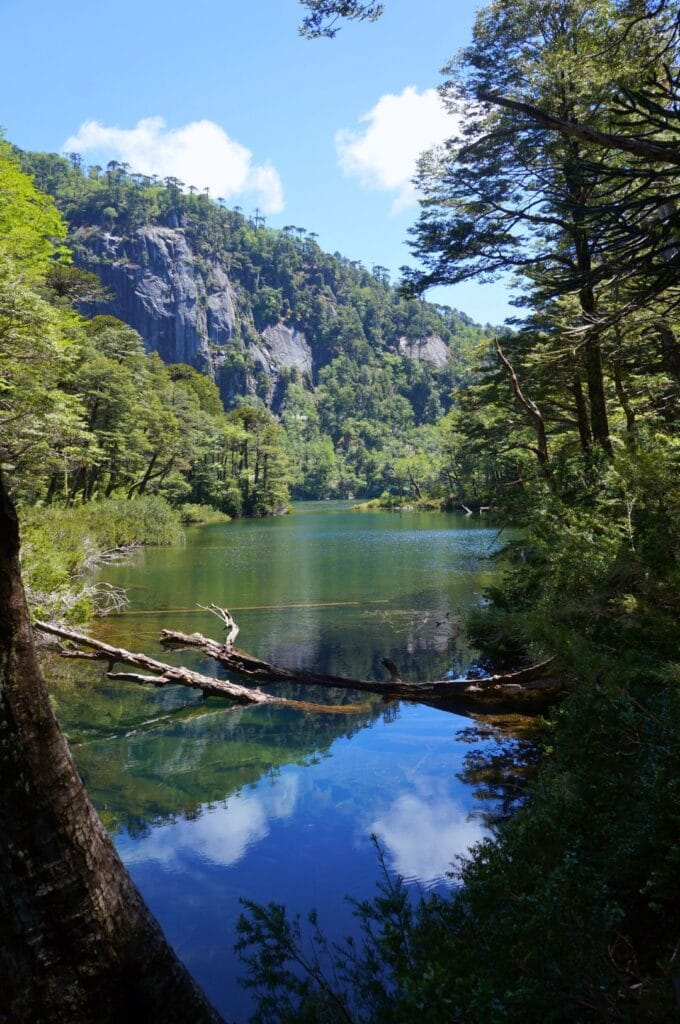
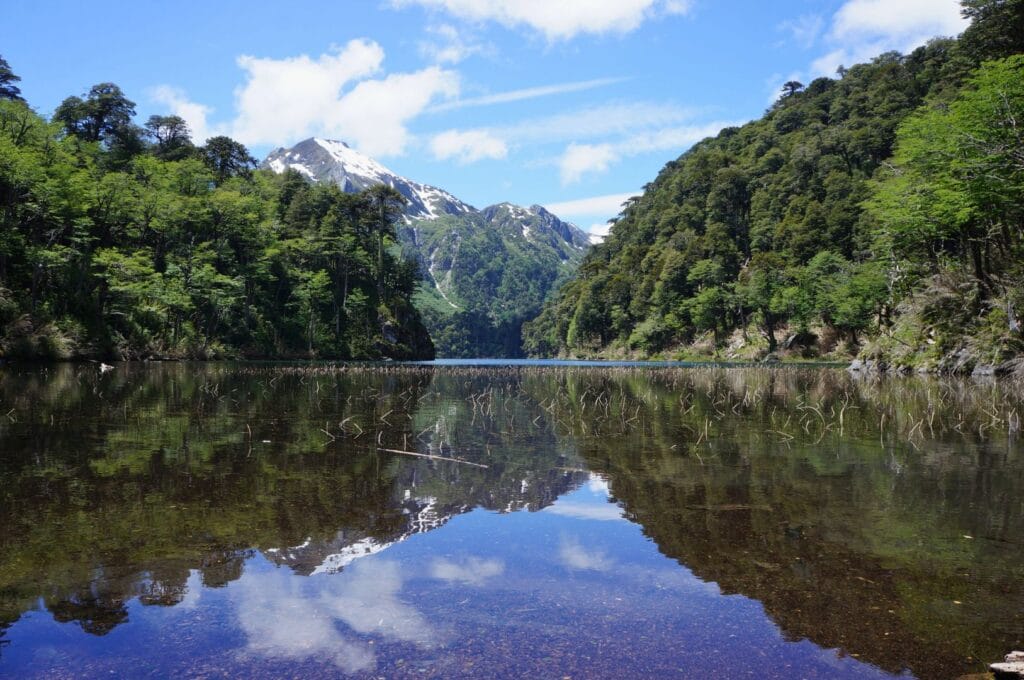
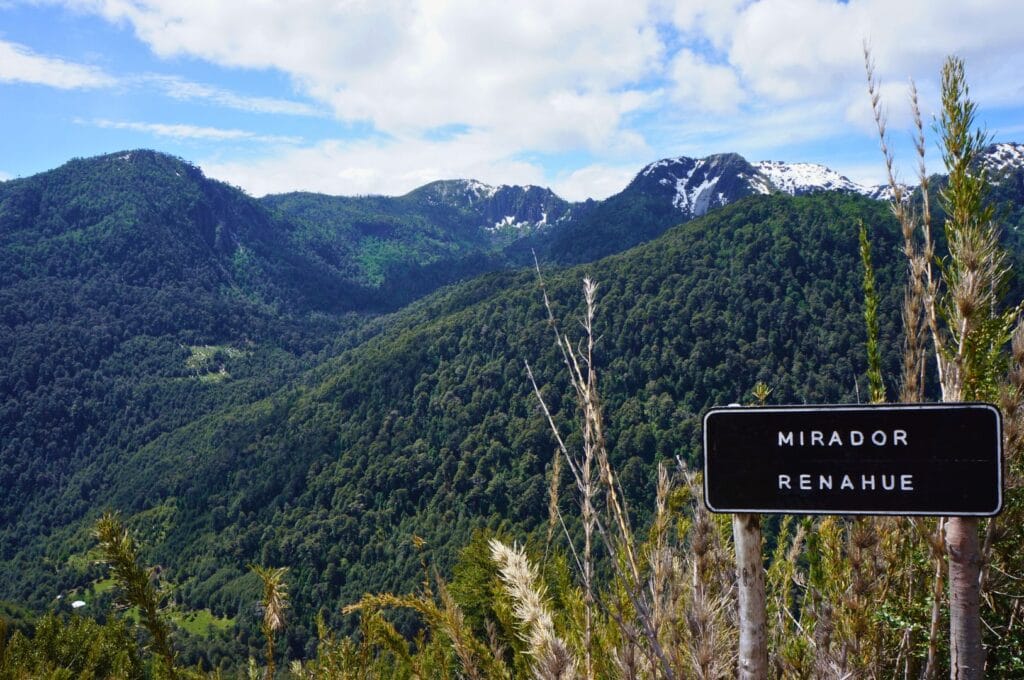
Practical information for visiting Huerquehue Park
- Transport from Pucón: Take the Carburgua bus from the terminal on Uruguay Avenue in Pucón. The ride costs 2,000 pesos per person and takes about 1 hour (4,000 pesos round trip). The bus departs daily at 8:30 a.m., 1:00 p.m., and 4:30 p.m., taking you directly to the park entrance. The return bus leaves the park at 9:30 a.m., 2:10 p.m., and 5:10 p.m.
- Opening hours: The park is open from Tuesday to Sunday, 8:30 a.m. to 6:30 p.m.
- Entrance fee: The price is 10,000 pesos per person, payable online before your arrival, as there is no ticket office on-site. If you plan to camp in the park, an additional 10,000 pesos per tent is required.
- Camping and lodging: The only place where camping is allowed in the park is at Olga Camping by Lake Tinquilco. The price is 18,000 pesos for two nights minimum for two people. For other accommodation options, there are refuges or lodges, and Olga Campground also offers other types of lodging.
- Visiting: The trails are extremely well-marked for day hikes. Depending on the season, some trails may be closed due to snow. Ask locals or the park’s entrance staff for current conditions.
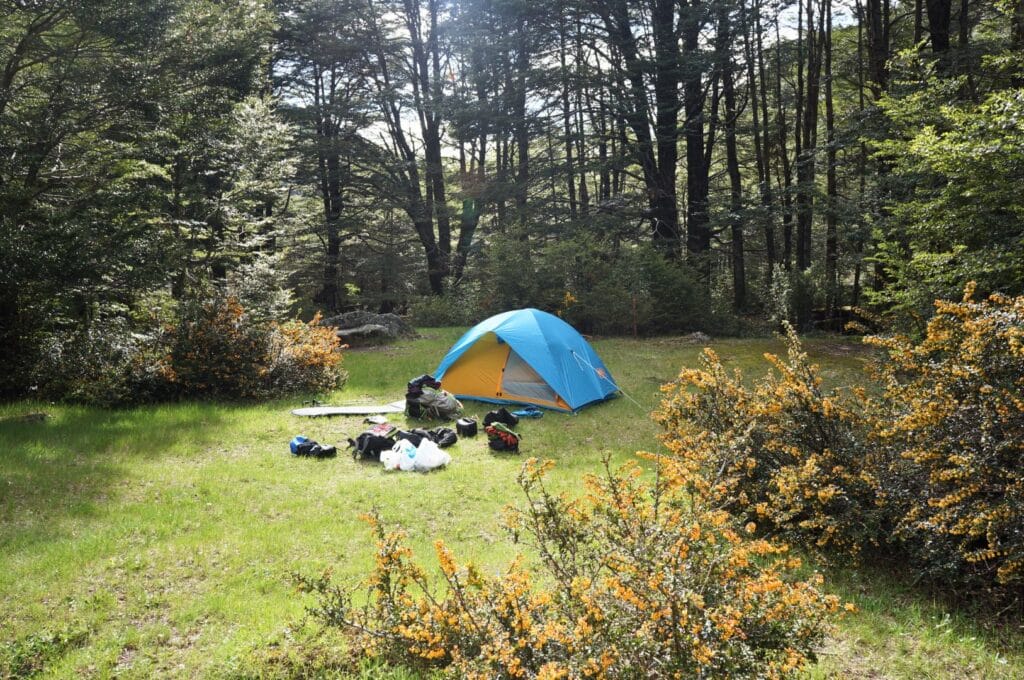
Hot springs around Pucón
If you enjoy hot springs, there are plenty of options in the area! Here are three we recommend:
Termas de Rio Blanco, pure bliss
After camping overnight in Huerquehue Park, we had two options: return to Lake Tinquilco or continue to Termas de Rio Blanco. Tough choice: a lake at 12°C or hot springs? You can guess which one we chose!
The trail was less well-marked and poorly maintained. We crossed streams, trudged through mud, and descended into a riverbed. After just 3 hours of hiking, we arrived, covered in mud, at the hot springs!
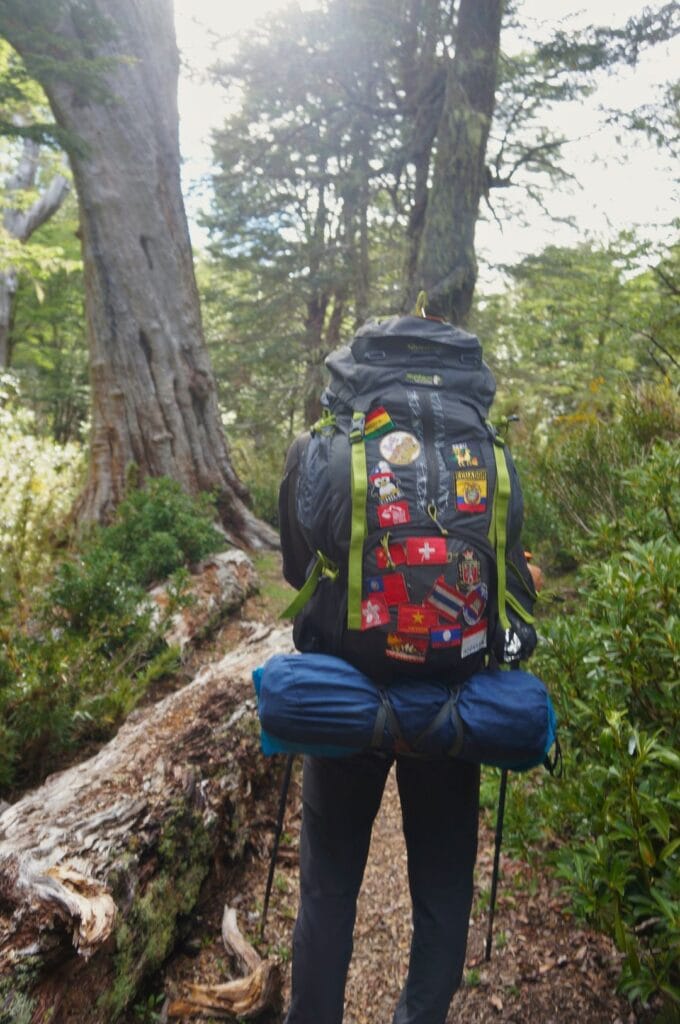
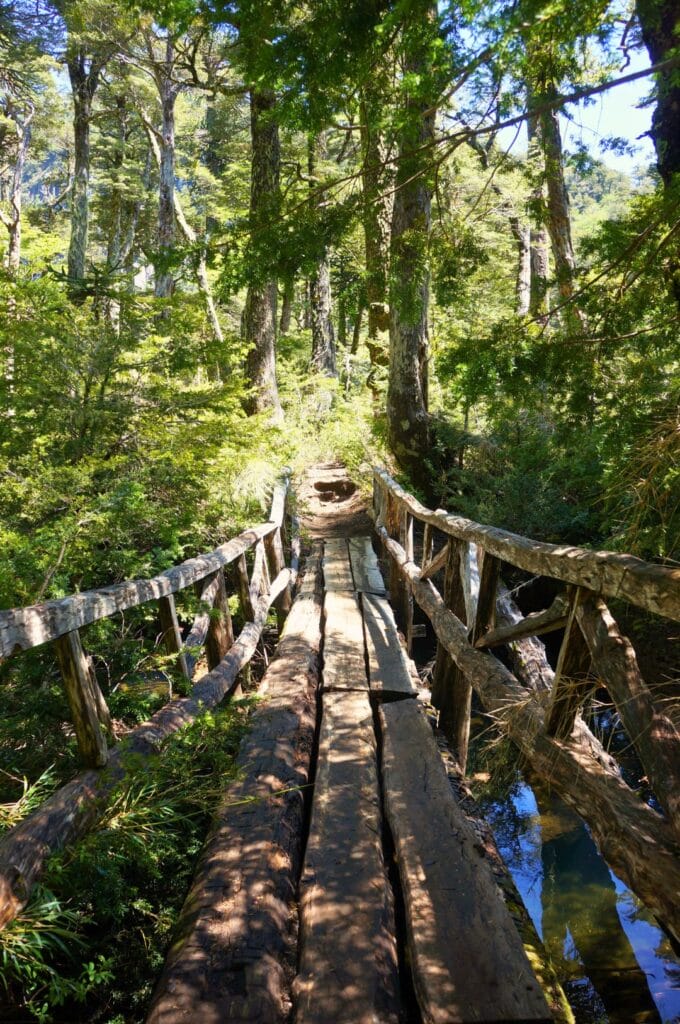
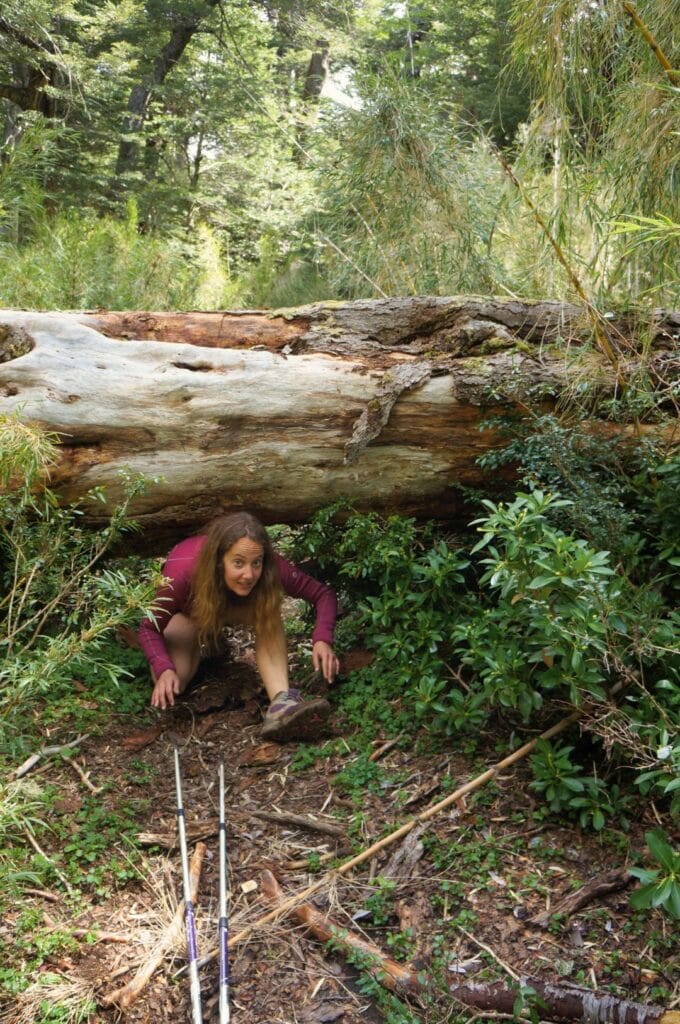
We originally planned to return to camp after enjoying the hot springs, but once we saw the stunning setting of the Rio Blanco thermal springs—two natural hot pools, one at 38°C and the other at 49°C, with a view of the valley and the option to camp just 2 meters from the pools—we decided to stay!
We met a Swiss-German couple, an Israeli, and a German along the way, and we all hit it off. We ended up spending the day in this little piece of paradise, relaxing, chatting, and having drinks in the hot baths. A great evening under the starry sky.
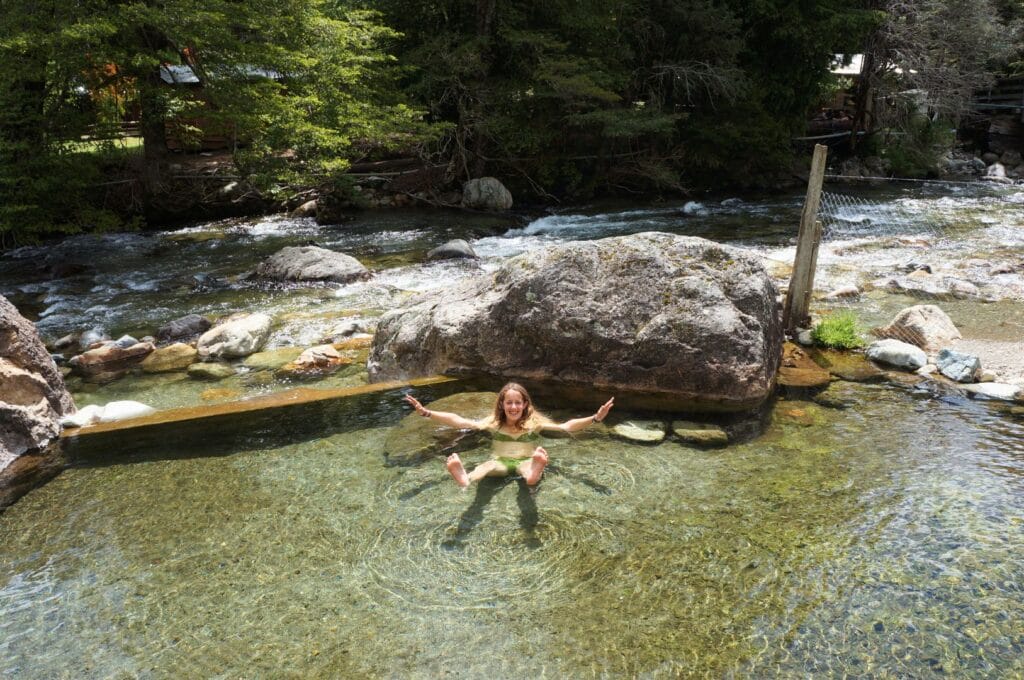
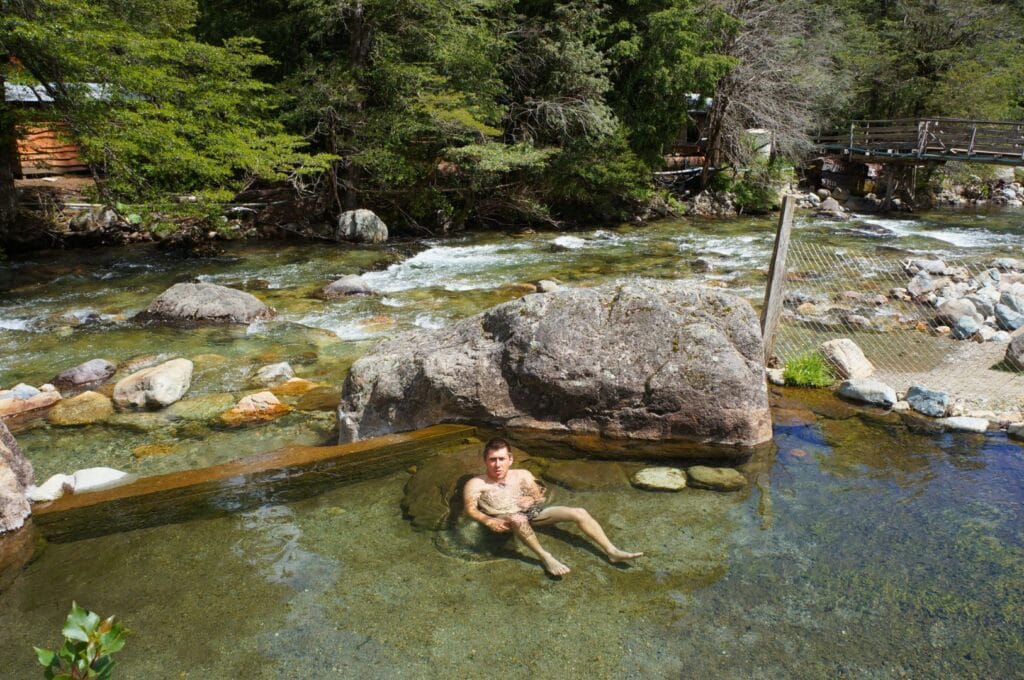
It’s no longer possible to reach the San Sebastian hot springs or the Eco Termas Rio Blanco from the Lakes Trail in Huerquehue Park. The only way to get there is by road from Pucón. You’ll find several baths there, but we recommend going to the Eco Termas Rio Blanco, which are natural pools, unlike the others, which are more like concrete pools. The cost is 15,000 pesos per person for access to the baths and camping next to the pools. The site is equipped with restrooms, running water, showers, and a grill.
Los Pozones hot springs
Open daily from 11 a.m. to 8 p.m., Termas Los Pozones consist of five natural pools. Everything is clean and well-maintained. For 2 hours of bathing, the entrance fee is 15,000 pesos, payable on-site (cash only). To get there, buses depart from Pucón’s Pullman terminal on Palguin Street. The round-trip ticket costs 5,000 pesos per person, and the journey takes about 45 minutes.
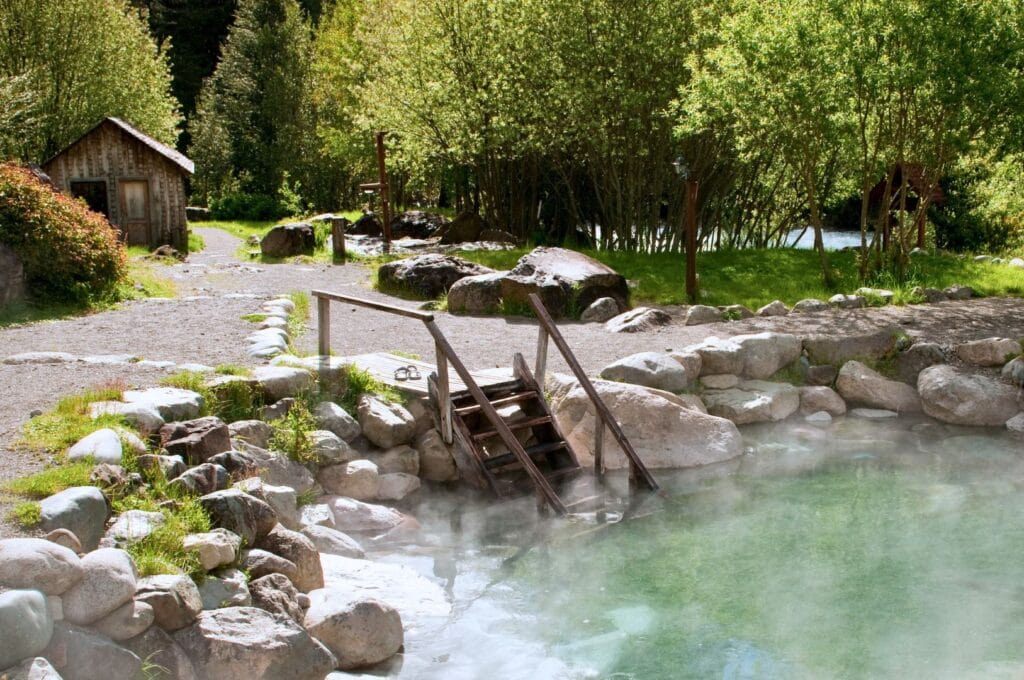
Geometricas hot springs
Termas Geometricas are probably the most expensive in the region, costing between 42,000 and 48,000 Chilean pesos per person. Their unique feature? Several dozen pools of varying temperatures are connected by red wooden walkways that wind through a lush forest. One advantage over the other hot springs is that no matter when you arrive, you can stay in the baths until closing at 7 p.m. Surprisingly, the hot springs are also famous for their on-site pizzas!
You can buy tickets online or on-site. To get there from Pucón without a car (note that the access road is tricky if you don’t have a 4×4), you can:
- Join a guided tour with transportation and tickets included;
- Take a bus to Villarrica (20 minutes), then another bus to Coñaripe (1 hour 20 minutes). Once there, you can easily find a taxi to the hot springs;
- Take a taxi directly.
Conguillío National Park
This park would have been part of our itinerary if we had a bit more time. If you have the opportunity to visit Conguillío National Park, don’t hesitate! The stars of the show are the Llaima Volcano (3,125 meters) and Sierra Nevada Volcano (2,554 meters), along with stunning lagoons, all set in a breathtaking landscape of Araucaria trees. (As you’ve probably gathered, Araucanía is a region of mountains, endemic flora, and incredible lakes. ;))
Conguillío Park map
We’ve marked the hiking trails on a map, and you can download the GPS tracks here.
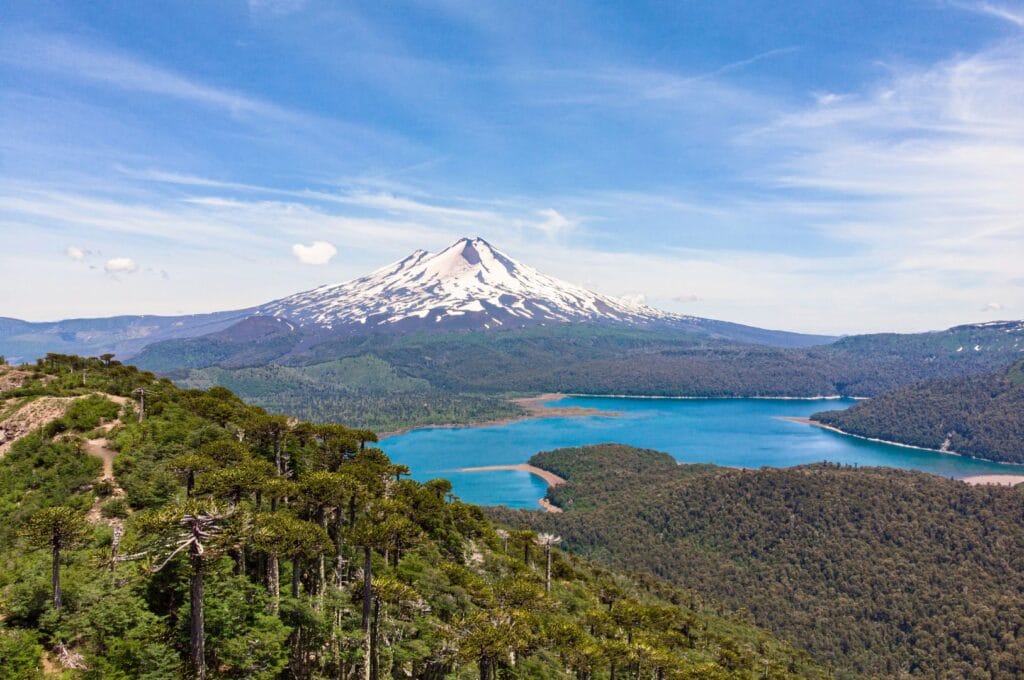
Hikes in Conguillío Park
- Sierra Nevada trail (in red): 12 km, 600 meters of elevation gain, 5 hours of hiking. This is the park’s iconic trail! The path climbs the foot of the Sierra Nevada Volcano, offering a stunning view of its neighbor Llaima and Lake Conguillío! If you had to choose just one hike, we’d recommend this one. As it’s a popular trail, we suggest starting your visit to the park here.
- Beach trail (in blue): 7 km, 90 meters of elevation gain, 2 hours of walking. This is the easiest walk in the park, as you stroll along the beach by the crystal-clear waters of Lake Conguillío. And even though it’s flat, the scenery is breathtaking!
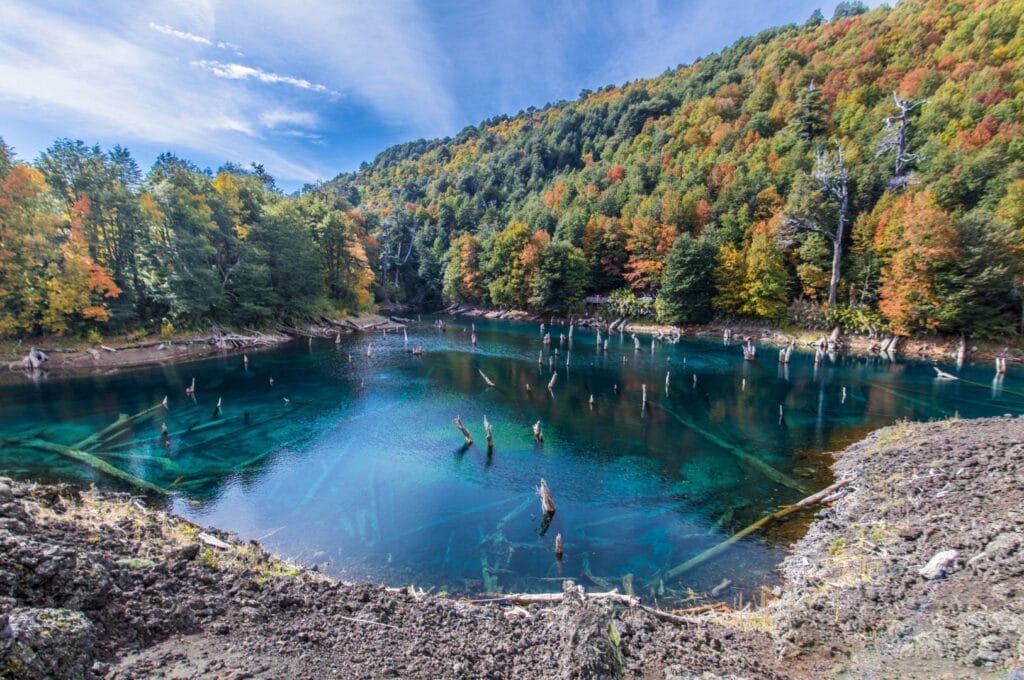
- Lagunas Arcoíris and Verde (in green): These are more like short walks than hikes, but they’re among the park’s highlights due to their incredible beauty! They’re two brief stops with very enjoyable short walks.
- The Truful Truful Canyon and Waterfall (in yellow): This is more of a walk as well, but the trail leads to an impressive canyon where the Truful Truful Waterfall cascades down. Not to be missed!
- Laguna Espejo (in purple): 21 km, 960 meters of elevation gain. Lesser-known but more demanding, this trail on the northern side of the park climbs the slopes of Sierra Nevada to Laguna Espejo for a breathtaking view.
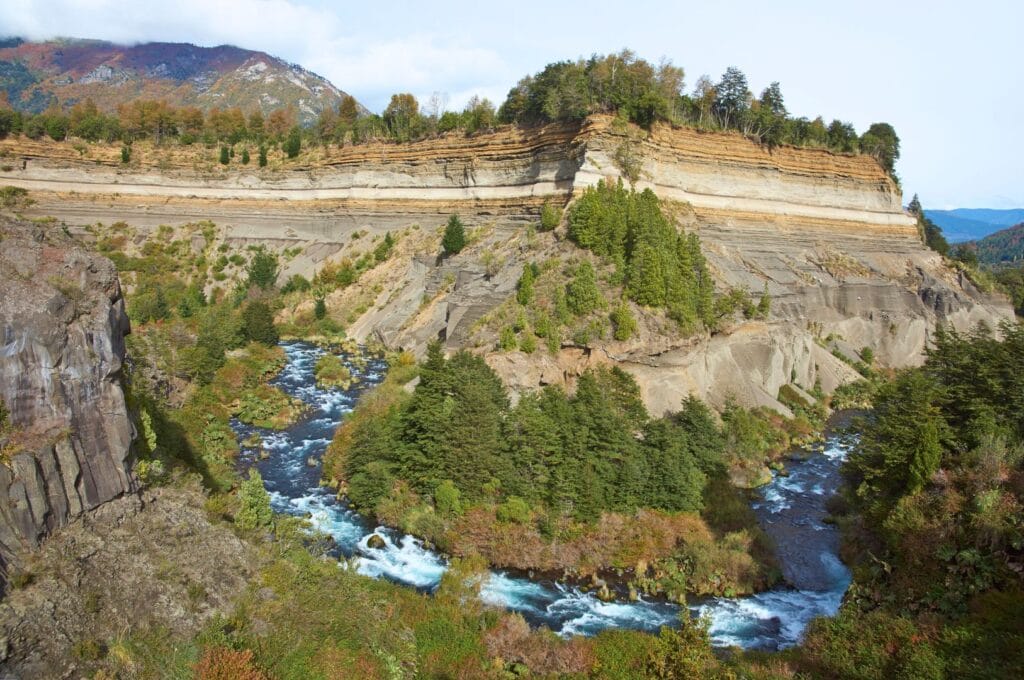
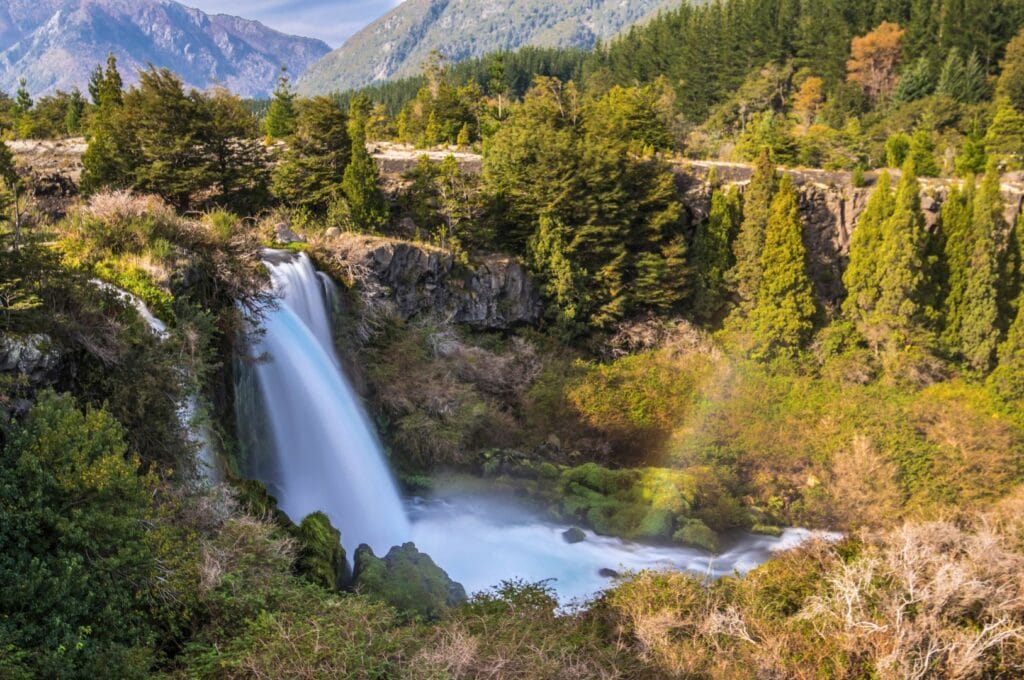
Practical information for visiting Conguillío Park
- Transport from Pucón: The park is located 2.5 hours north of Pucón. If you rent a vehicle, it’s an easy trip. Getting there by public transport is a bit more complicated but possible! You’ll need to reach Melipeuco, a small town at the southern entrance of the park. To do so, take a JAC bus from Pucón to Temuco, then another bus from Temuco to Melipeuco. Once there, hitchhiking works pretty well to get to the park, or you can find vehicles to take you there.
- Opening hours: The park is open from Tuesday to Sunday, 8:30 a.m. to 6:30 p.m.
- Entrance fee: The entrance ticket costs 13,000 pesos per person, and must be booked online.
- Camping and lodging: The park offers plenty of lodging options. Campsites start at 7,000 pesos per night, and cabin rooms cost a minimum of 80,000 pesos.
- Visiting: Most of the trails are open year-round. Ask locals or at the park entrance about trail conditions if you’re visiting in the heart of winter.
The Waterfall Route to Argentina
Something we didn’t do but would have loved to is the waterfall hunting along Route S-941, east of Pucón. It’s somewhat like the famous Ruta de las Cascadas in Baños! If you have a car, no worries, it’s easily accessible. By public transport, it’s a bit trickier, but buses run between Pucón and Curarrehue. Ask them to drop you off at Llafenco or Palguin Bajo. From there, you should be able to find a vehicle, or worst case, try hitchhiking—it works well in this area! Here are the notable waterfalls:
- Salto los Mellizos: These two beautiful waterfalls are at the end of a short trail (400 meters) inside an adventure park (with ziplining and tree-climbing). To view the falls, the entrance fee is 3,000 pesos per person.
- Salto Palguin: A nice, powerful waterfall (3,000 pesos per person), worth seeing if you’re a waterfall enthusiast. Otherwise, we recommend the next one.
- Salto La China: This is undoubtedly the most impressive waterfall! Standing 80 meters tall, you can reach its base via a wooden footbridge. There’s also the option to zipline in front of the waterfall, surrounded by nature. Entrance costs 3,000 pesos.
- Salto El Léon: The most expensive waterfall in the area, with an entrance fee of 4,000 pesos. Here, you can enjoy heated pools with a view of the waterfall.
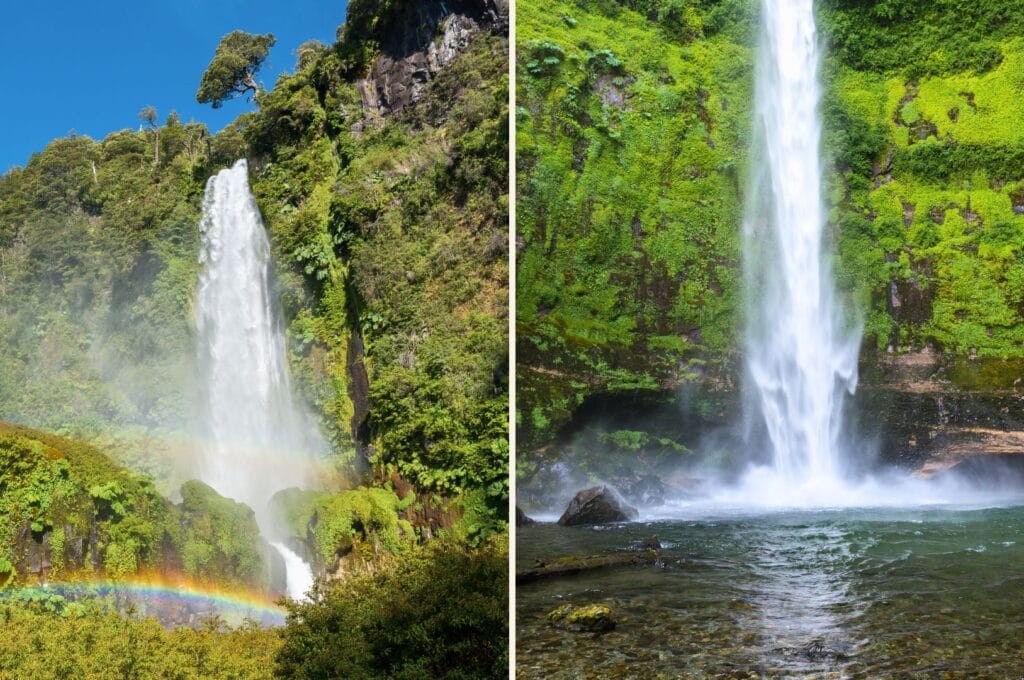
And there you have it! That’s everything you need to know about Pucón, our first stop in Patagonia. It was a fantastic appetizer, especially since the weather was perfect throughout our visit! We’ll catch up with you from Puerto Varas and Vicente Pérez Rosales National Park in the Lakes Region. We’ve got our eyes on a new trek that combines hiking and hot springs! What can we say, we’re not ones to slack off! 🙂 And you, what did you think of Pucón?
Pin it
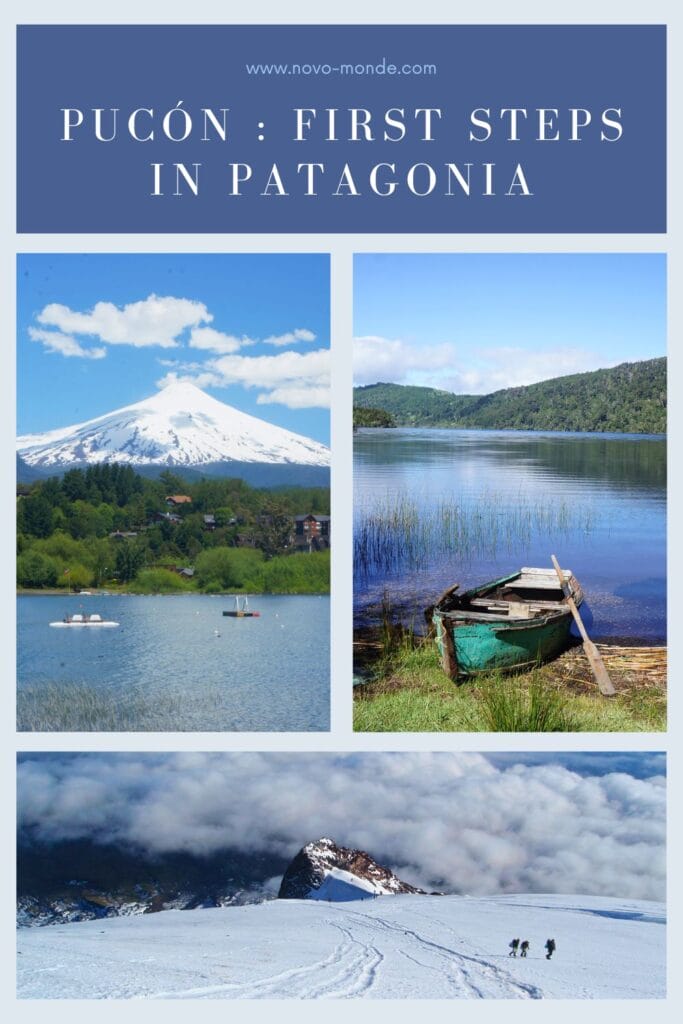
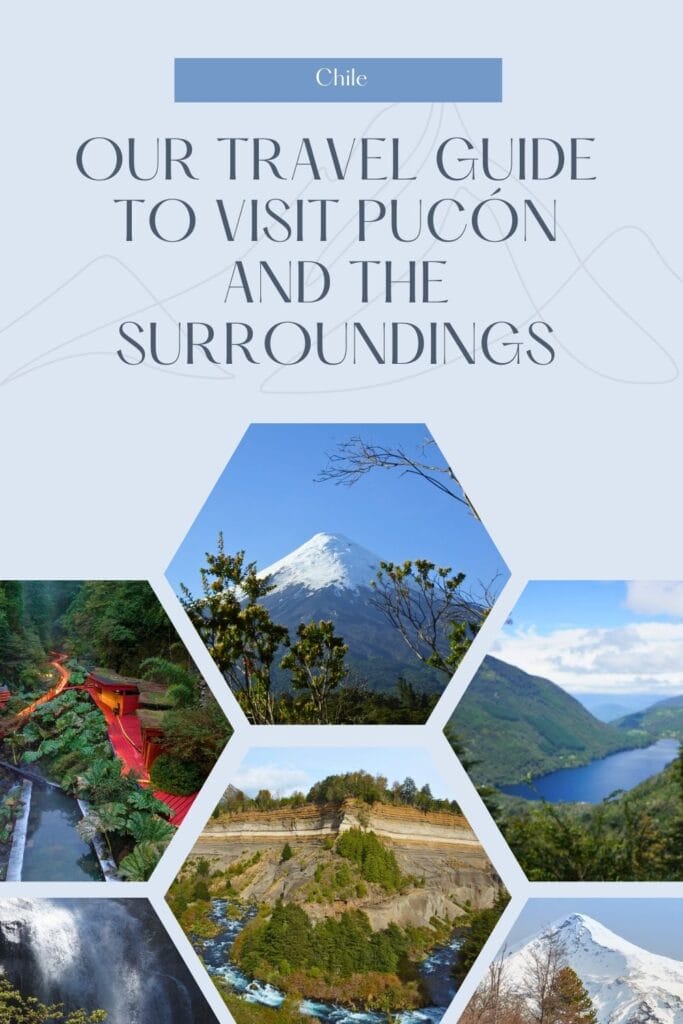
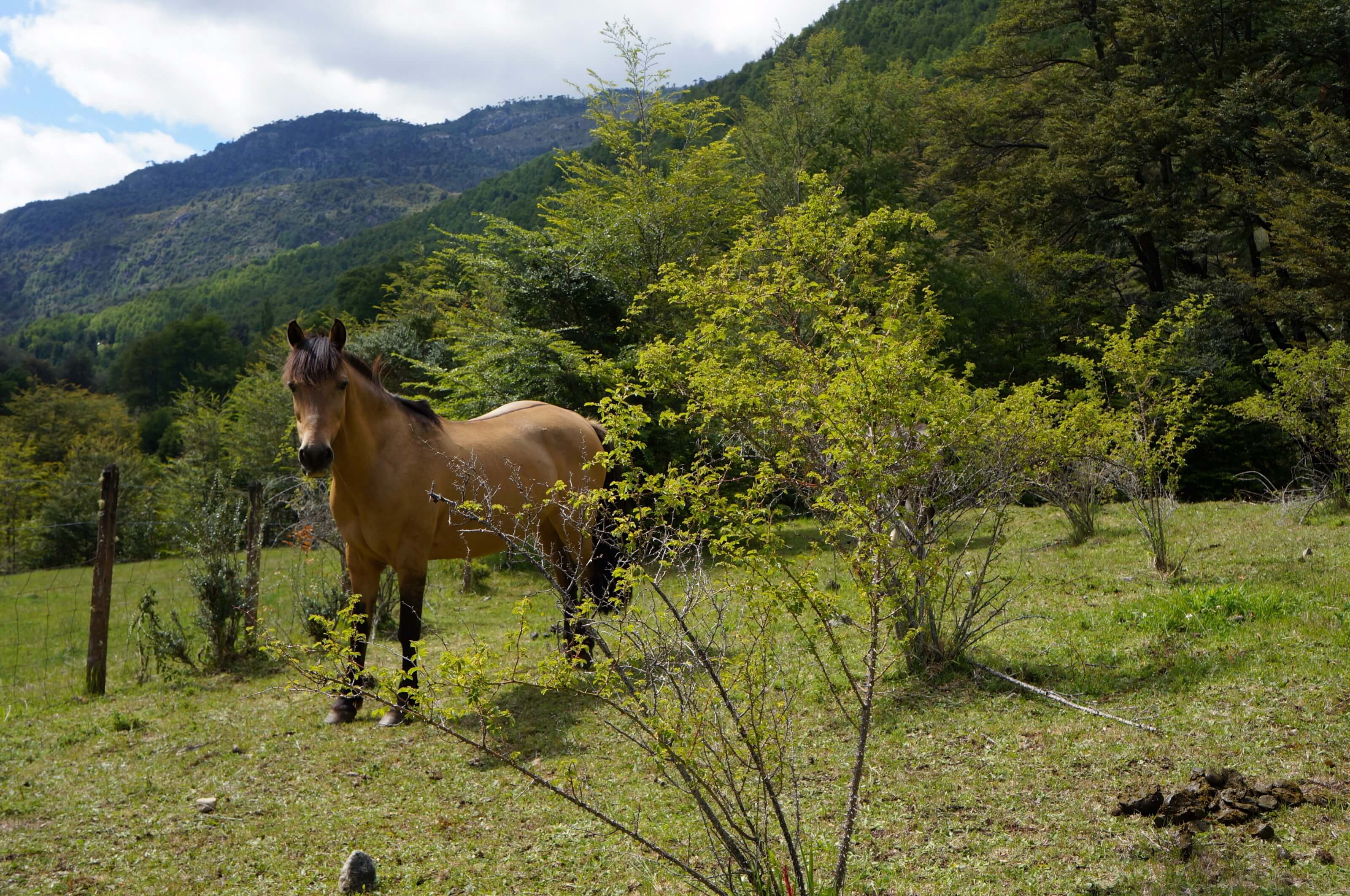
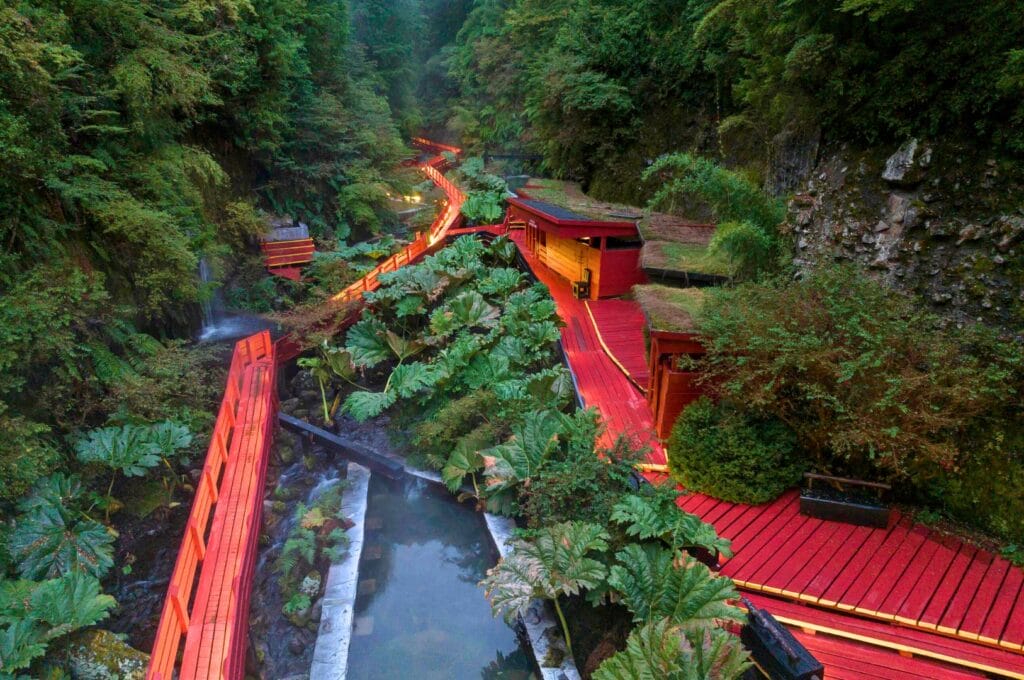

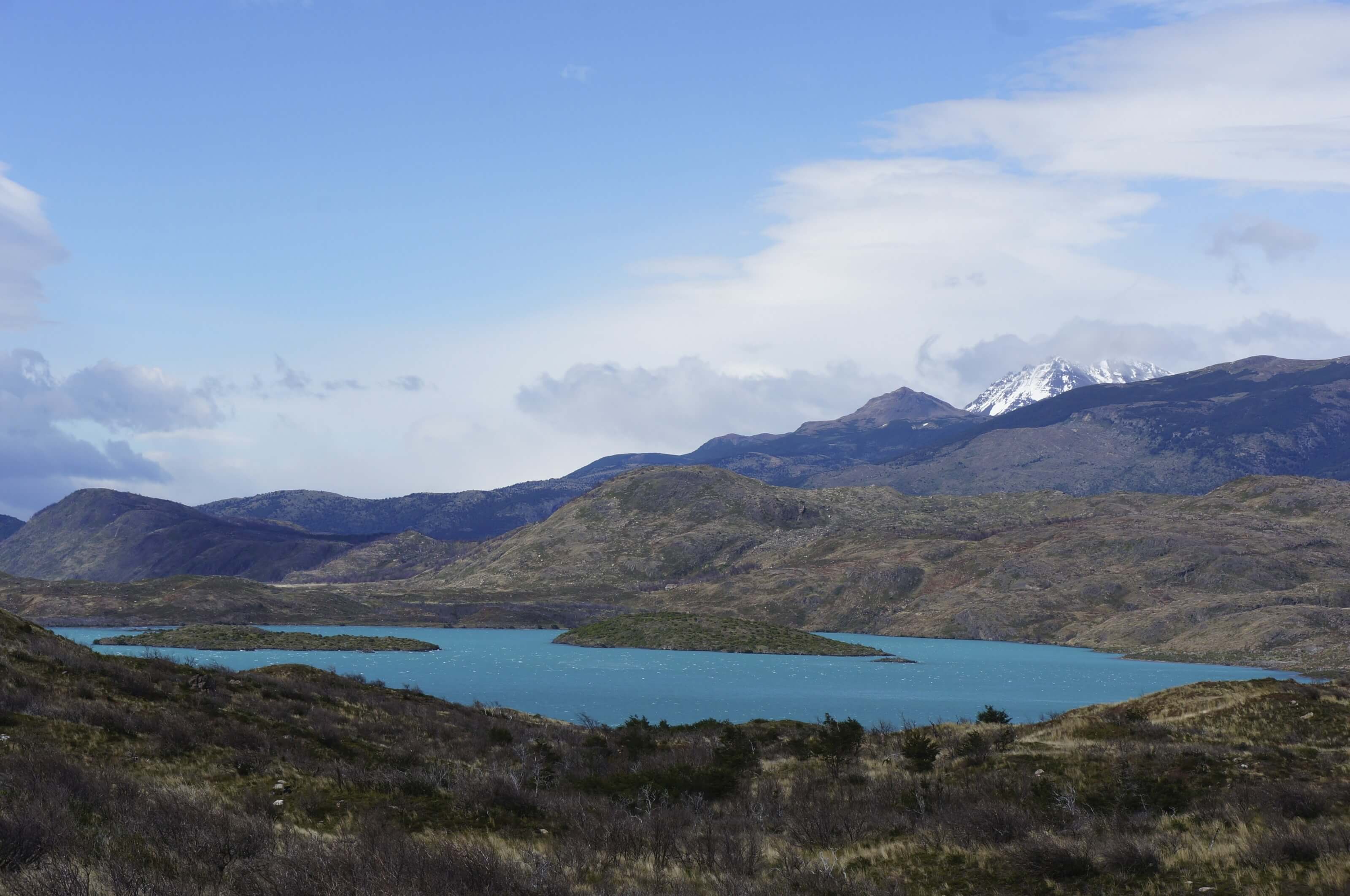
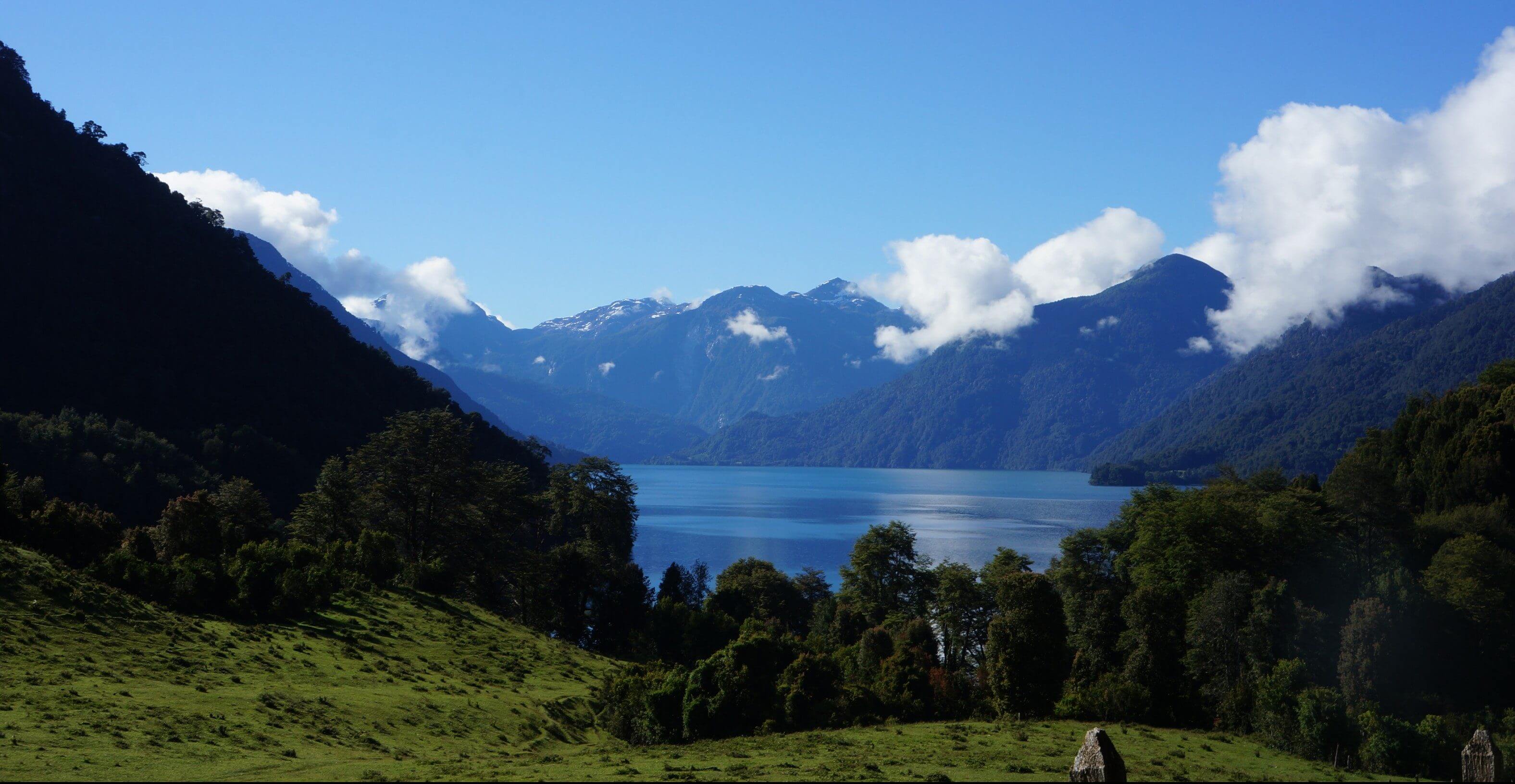
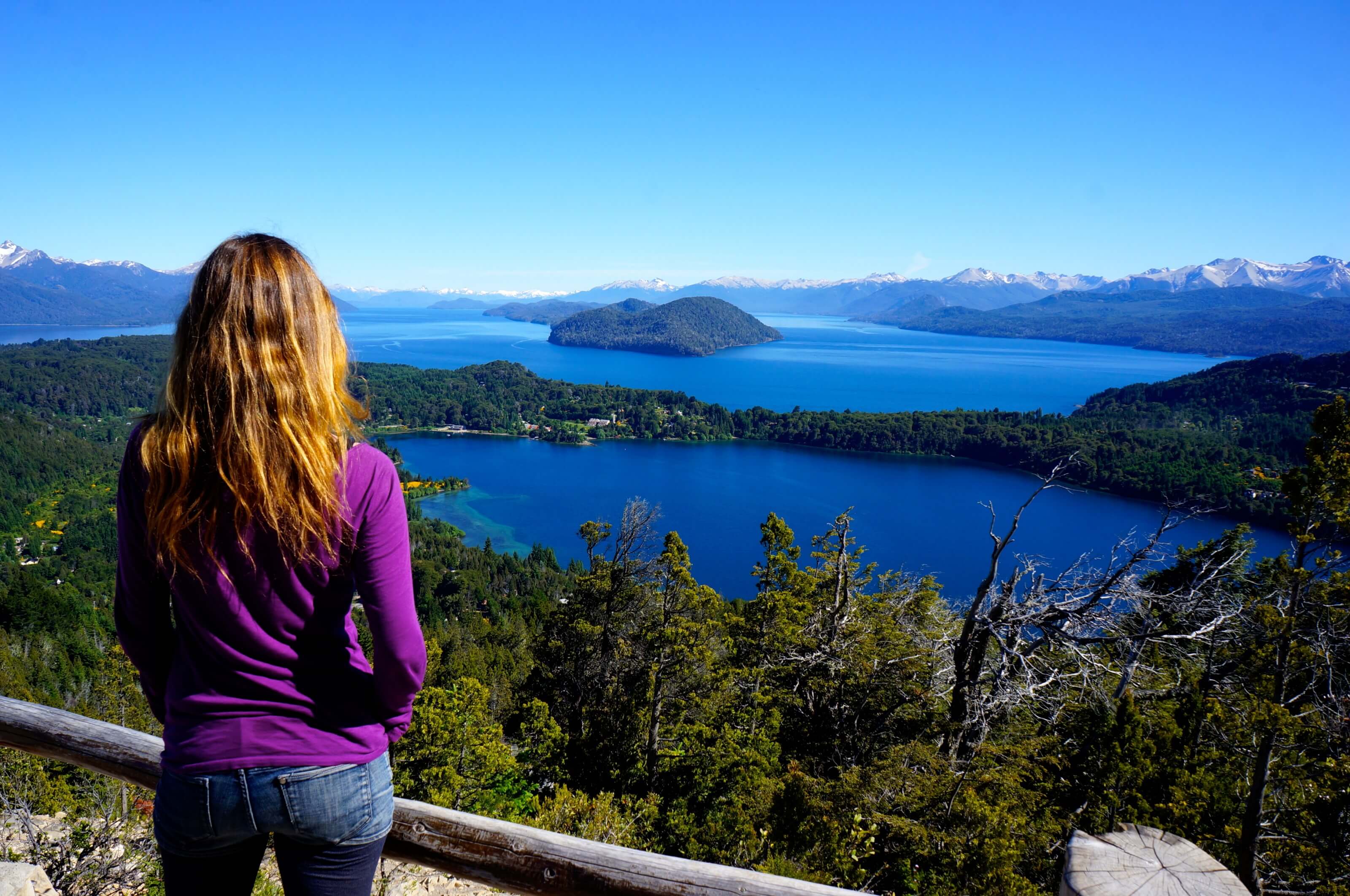
Join the discussion